Bringing Dogs From Mexico to the US in 2023

Bringing dogs from Mexico to the US is a very straight forward process, as long as you are aware of the requirements, and plan ahead.
As long as your dog has remained in Mexico for the past 6 months, bringing dogs from Mexico to the US is easy. You will simply need to visit the vet and organise your means of travel. Your dog will require a health certificate at minimum to show that he is healthy. If your dog has travelled to a high-risk country, your dog will also need a microchip and rabies vaccination. Depending on the size, weight of your dog, and your chosen airline, your dog may fly in the cabin or the cargo area of the plane.
In this article, we will discuss in detail everything you need to know when bringing dogs from Mexico to the US. Including, the process, requirements and cost.

What is the process of bringing dogs from Mexico to the US?
Visit the vet..
In order to enter the US from Mexico with a dog, your dog must have a health certificate. A health certificate is required to show that your dog is fit and healthy, and does not pose as a risk to other dogs in the US.
When bringing dogs from Mexico to the US, they are not usually required to have microchips, rabies vaccinations or any parasite treatments. However, if your dog has travelled to a high-risk country in the previous 6 months, he will.
The vet will simply check the health of your dog to ensure he is fit and healthy to travel. Once your pet has had a full health check, they will provide you with an official health certificate .
Organise travel.
Traveling by air.
Depending on the airline you fly with and the size/weight of your dog, they may be able to fly in the cabin, or in the cargo hold.
Airlines that allow dogs to fly in the cabin, usually only permit very small and light dogs. This is because they must fit in a travel carriers under the plane seats. Therefore, it is likely your dog must fly in the cargo area of the plane. Although this sounds scary, according to the IATA , pets often travel better this way as it is quieter and darker.
All dogs traveling unaccompanied must be claimed by someone with legal residence status in the US. They must have a valid US address.
Please note that some airlines restrict certain breeds, so be sure to check before you travel.
Dogs are permitted to enter the US in many cities including but not limited to New York, Chicago, Washington DC, Atlanta, Miami, Houston, Los Angeles, Seattle and Chicago.
Related posts: 21 Airlines That Allow Flying With Dogs In-Cabin [Pet Policies] Airlines that Allow Flying with a Large Dog in Cabin [Pet Policies] 21 Dog Breeds That Can Fly in Cabin Flying Dogs in Cargo: How Safe is it?
Traveling by car.
Bringing dogs from Mexico to the US in a car is more straight forward than flying. This is because you will not have to adhere to strict airline policies. You will simply need to follow the requirements above. At the US border, your dog’s health and documents will be checked. As long as your dog appears healthy and you have the relevant documents, you will be permitted in the US.
Examination on arrival.
On arrival, all domestic dogs will be examined by a vet to ensure that they are free of disease. If your dog is not in apparent good health, further examination by a licensed veterinarian may be required at the owner’s expense.
Requirements for bringing dogs from Mexico to the US.
The requirements for bringing dogs to Mexico from the US depends on whether your dog has remained in Mexico for the past 6 months. If so, the process will be easier.
If your dog has remained in Mexico for the past 6 months you will require the following:
- Health certificate to show that your dog is fit and healthy.
- Oral confirmation that your dog has lived in Mexico for the past 6 months or since birth.
- Additional vaccinations depending on which state you are travelling to. Check with your destination state’s health department before you leave on your trip.
If your dog travelled to a high-risk country in the past 6 months you will require the following:
- A microchip that was inserted before your dog’s rabies vaccination.
- Rabies vaccination that is up to date. Dogs that have never been vaccinated can enter the US after 28 days of vaccination. If your dog has kept up to date on all rabies vaccinations, including 12 month boosters, no waiting period is required.
High-risk countries.
The US considers the following countries to be high-risk for rabies:
Afghanistan, Algeria, Angola, Armenia, Azerbaijan, Bangladesh, Belarus, Belize, Benin, Bolivia, Botswana, Brazil, Burkina Faso, Burundi, Cambodia, Cameroon, Central African Republic, Ceuta, Chad, China (excluding Hong Kong, Macau, and Taiwan), Colombia, Comoros, Côte d’Ivoire (Ivory Coast), Cuba, Democratic Republic of the Congo, Djibouti, Dominican Republic, Ecuador, Egypt, El Salvador, Equatorial Guinea, Eritrea, Eswatini (Swaziland), Ethiopia, Gabon, Gambia, Georgia, Ghana, Guatemala, Guinea, Guinea-Bissau, Guyana, Haiti, Honduras, India, Indonesia, Iran, Iraq, Jordan, Kazakhstan, Kenya, Kuwait, Kyrgyzstan, Laos, Lebanon, Lesotho, Liberia, Libya, Madagascar, Malawi, Malaysia, Mali, Mauritania, Melilla, Moldova, Mongolia, Morocco, Mozambique, Myanmar (Burma), Namibia, Nepal, Niger, Nigeria, North Korea, Oman, Pakistan, Peru, Philippines, Qatar, Republic of the Congo, Russia, Rwanda, São Tomé and Príncipe, Saudi Arabia, Senegal, Sierra Leone, Somalia, South Africa, South Sudan, Sri Lanka, Sudan, Suriname, Syria, Tajikistan, Tanzania (Including Zanzibar), Thailand, Togo, Tunisia, Turkey, Turkmenistan, Uganda, Ukraine, United Arab Emirates, Uzbekistan, Venezuela, Vietnam, Western Sahara, Yemen, Zambia, Zimbabwe.
How much will bringing dogs from Mexico to the US cost?
Bringing dogs from Mexico to the US should not cost you too much. The cost will depend mainly on how you are planning on traveling to the US from Mexico.
The cost for bringing dogs from Mexico to the US is broken down into the following potential fees:
- Health certificate – the average cost of a veterinary consultation can be between $25 and $150. However, some charities offer this service for free.
- Microchipping – this is only required if your dog has traveled to a country the US considers high-risk for rabies. The average cost of a microchip is around $25 to $75.
- Rabies vaccination – this is only required if your dog has traveled to a country the US considers high-risk for rabies. The average cost of the one-year rabies vaccination is around $15 to $20. A three-year shot will usually costs around $35 to $50. However, some charities offer this service for free.
- Airline fees – the cost will vary widely depending on which airline you fly with, the size and weight of your dog. Of course, different airlines charge different amounts for shipping dogs. Additionally, they usually charge depending on the weight and size of your dog.
- Travel carrier – if you are traveling by air, you will need to ensure your dog is traveling in a secure, IATA approved travel carrier.
For information on how much a US Pet Passport costs, check How Much Does a US Pet Passport Cost? .
How long does it take to bring dogs from Mexico to the US?
It shouldn’t take you long to take a dog from Mexico to the US as there are not many requirements that must be met.
If your dog has resided in Mexico for it’s whole life, or at least for the last 6 months, then you will just need to take your dog to the vet for a health check. You will not require any vaccinations or parasite treatments.
However, if your dog has traveled to a country that the US considers high risk for rabies, then the process may take a little longer. If this is the case, your dog will need a rabies vaccination. Once your dog has been vaccinated against rabies, you will have to wait 28 days before you can enter the US.
Bringing dogs from Mexico to the US for Commercial Reasons
The USDA APHIS Animal Care has separate requirements when bringing dogs from Mexico to the US for the purpose of resale or adoption.
Puppies and dogs entering the US intended for resale or adoption must:
- Be 6 months of age;
- Be fully vaccinated (rabies and distemper, hepatitis, leptospirosis, parvovirus, and parainfluenza virus (DHLPP); and
- Accompanied with an import permit
An exception would be dogs being imported for veterinary treatment that is unavailable in the originating country or dogs being imported for research purposes.
Tips for bringing dogs from Mexico to the US
- Get your pet used to its carrier before traveling.
- Purchase flights with fewer connections or layovers.
- Choose departure and arrival times to avoid extreme heat or cold.
- Consult with your veterinarian.
- If driving, take plenty of pit stops.
- If flying, walk your pet before leaving home and again before checking in.
- If your pet is allowed in the cabin, check in as late as possible to reduce stress.
- If your pet will be transported as cargo, check in early so it can go to the quiet and dimly lit hold of the plane.
What airlines allow flying a dog to the US?
Most airlines allow flying a dog to the US. However, depending on the airline you fly with, pet policies differ.
When flying with a dog from Mexico to the US, it’s important to check airline pet policies before booking any travel. Different airline’s have different rules for flying with dogs, including which dog breeds are allowed, the size and weight of dogs that are permitted, and the number of dogs they allow. Fees also vary between airlines.
Most airlines will allow dogs to fly in the cargo section of their planes, in a climate controlled, comfortable pet zone. Although some pet owners think this will be stressful for their dogs, it can actually be a lot calmer than flying in the cabin.
Some airlines will allow dogs to fly in the cabin with their owners, but generally only small dogs that weigh under 8kg are permitted. This is because dogs must fly inside an airline-approved carrier that fits under the seat in front of their owners.
Related posts: 21 Airlines That Allow Flying With Dogs In Cabin [2023 Pet Policies] 21 Dog Breeds That Can Fly in Cabin [2023] Flying Dogs in Cargo: How Safe is it?
Guidelines for Dog Carriers.
If you are flying from Mexico to the US with a dog, it is important that you use a dog carrier that is approved by your airline. Different airlines have different pet carrier policies, which often vary between aircrafts and routes. Check that your pet carrier is approved for your chosen airline, aircraft and route.
The rules and regulations have been set out by International Air Transport Association (IATA) ensure that dogs are comfortable when travelling. Thus, inside their travel carriers, dogs must be able to stand up, turn around and lie down in a natural position in their kennel (without touching any side or the top of the container).
The rules for pet carriers also vary depending on whether your dog will be flying in the cabin or cargo area of the plane.
If you are travelling in the cabin with your dog, then you will need to ensure that it fits under the seat in front of you. This is why only small dogs weighing under 7-8kg are permitted in the cabin.
Furthermore, airlines often require that your dog must be obedient to your commands and must behave appropriately in public. Thus, he mustn’t bark or growl at other passengers or staff. If your dog does not behave in an appropriate manner, some airlines may transfer him to the cargo hold at an additional cost, or refuse to transport him all together. Some airlines require a consent form to ensure your pet is flight-ready.
For a list of airlines that allow dogs to fly in the cabin with their owners, check 21 Airlines That Allow Flying With Dogs In-Cabin [Prices & Policies] .
Recommended dog carriers.
Frequently Asked Questions [FAQs]
Is quarantine required when bringing a dog from Mexico to the US?
In most cases, quarantine is not required. As long as your dog appears healthy upon arrival in the US, they will not need to be quarantined.
Can I bring my puppy from Mexico to the US?
Yes, as long as your puppy has a health certificate and seems healthy upon inspection. Puppies entering the US for commercial use, for resale or adoption, require additional vaccines. Please refer to the section above.
Is there an entry fee when taking dogs to the US?
Luckily, there is no fee to pay when entering the US from Mexico.
Can I adopt a dog in Mexico and take it back to the US with me?
Of course, as long as the dog is healthy. You will need a health certificate, and potentially a rabies vaccination.
Bottom Line
Bringing a dog from Mexico to the US is straight forward. As Mexico is a country that the US considers to be low risk for rabies, you will simply need to take your dog to the vet for a health certificate, and organise travel.
If traveling by air, check that your chosen airline will allow your dog to travel with you either in the cabin, or in the cargo area of the plane. Different airlines have different policies and prices.
- 13 Airlines That Allow Flying With Dogs In-Cabin [Prices &Policies]
- How to get a US Pet Passport in 2023 [ULTIMATE GUIDE]
- How Much Does a US Pet Passport Cost in 2023?
- What are the Requirements for a US Pet Passport in 2023?
Related Articles
![travel from mexico to us with dog Photo of How to Safely Secure Dogs When Camping? [5 Methods]](https://www.petsthattravel.com/wp-content/uploads/2023/11/how-to-secure-dogs-when-camping-390x220.jpg)
How to Safely Secure Dogs When Camping? [5 Methods]
![travel from mexico to us with dog Photo of Do All Dogs Have Webbed Feet? [Breed Info & Paw Care]](https://www.petsthattravel.com/wp-content/uploads/2023/11/do-all-dogs-have-webbed-feet-390x220.jpg)
Do All Dogs Have Webbed Feet? [Breed Info & Paw Care]
![travel from mexico to us with dog Photo of Can Pit Bulls Swim? [Breed Facts & FAQs]](https://www.petsthattravel.com/wp-content/uploads/2023/11/can-pitbulls-swim-390x220.jpg)
Can Pit Bulls Swim? [Breed Facts & FAQs]
![travel from mexico to us with dog Photo of Do Newfoundland Dogs Like Water? [Breed Facts & FAQs]](https://www.petsthattravel.com/wp-content/uploads/2023/11/newfoundland-dog-water-390x220.jpg)
Do Newfoundland Dogs Like Water? [Breed Facts & FAQs]
Leave a reply cancel reply.
Your email address will not be published. Required fields are marked *
Save my name, email, and website in this browser for the next time I comment.
What Your Dog Needs to Enter the United States
CDC is extending its temporary suspension of dog importation from high-risk dog rabies countries until July 31, 2024. This suspension includes dogs arriving from countries without high risk of rabies if the dogs have been in a high-risk country in the past 6 months.
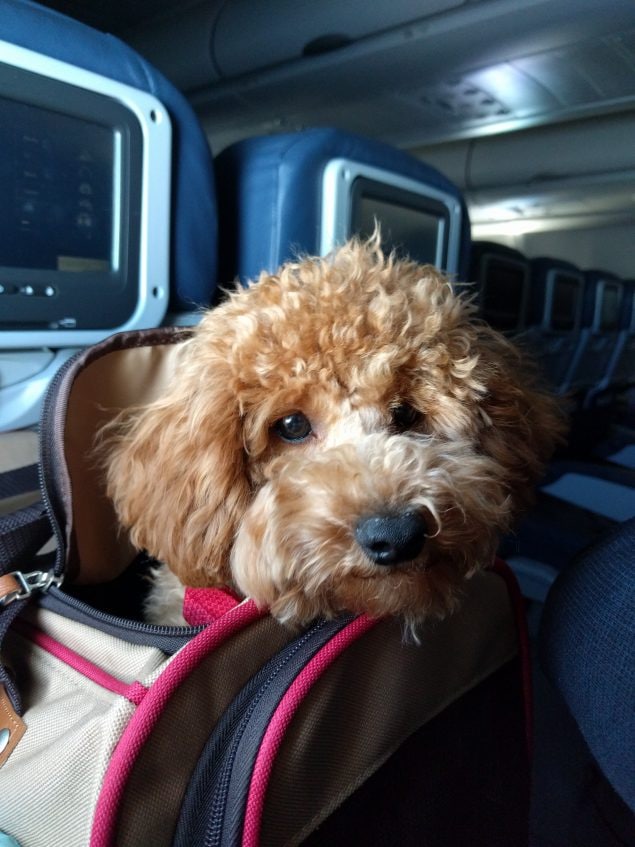
Photo credit: Audilis Sánchez, CDC
The rules for bringing your dog into the United States depend on where the dog has been in the past 6 months.
All dogs must appear healthy upon arrival. Dogs that arrive sick or injured will be required to undergo veterinary examination and testing at the importer’s expense to rule out diseases that can spread to people.
Documents Required in English
Written statements and any documents must be in English or have a certified English translation. A certified translation is a signed statement on professional letterhead issued by a licensed translator declaring that the translation is an accurate and true representation of the original document. The translation must include the name, address, and contact information of the translator and have a signatory stamp or elevated seal with the translator’s license number included. A certified translation service provider can be found online.
Dog from Countries Without High Risk of Dog Rabies
Dogs that have NOT been in a high-risk country in the past 6 months may enter the United States through any port of entry, and importers are NOT required by CDC to present rabies vaccination documentation. However, when your dog enters the United States, you must provide a written or verbal statement your dog has only been in a country NOT at high risk for at least 6 months or since birth if under 6 months of age. There is no limit to the number of dogs.
Dogs from High-Risk Countries for Dog Rabies
During the temporary suspension, options for bringing dogs that have been in a high-risk country for rabies within the past 6 months will depend on where the dogs’ rabies vaccinations were administered, and the number of dogs being imported.
All dogs from high-risk countries must:
- Appear healthy on arrival;
- Be at least 6 months old;
- The rabies vaccine must be administered by a licensed veterinarian on or after 12 weeks of age and at least 28 days before arrival if it is the dog’s first vaccination.
- Booster rabies vaccines administered after 15 months of age are valid immediately.
- Have an ISO-compatible microchip for identification listed on their U.S. rabies vaccination certificate or CDC Rabies Vaccination and Microchip Record [PDF – 1 page] .
- Meet the requirements of either Option A, B, or C below.
Option A : Present a valid U.S.-issued rabies vaccination certificate at one of 18 airports with a CDC port health station.
- Name and address of owner
- Dog’s breed, sex, date of birth (approximate age if date of birth unknown), color, and markings
- Dog’s ISO-compatible microchip number
- Vaccine product name, manufacturer, lot number, and product expiration date
- Date of rabies vaccination
- Date the vaccination expires (date the next vaccination is due)
- Name, license number or official seal, address, telephone or email address, date, and signature of veterinarian who administered the vaccine
- Anchorage (ANC), Atlanta (ATL), Boston (BOS), Chicago O’Hare (ORD), Dallas (DFW), Detroit (DTW), Honolulu (HNL), Houston (IAH), Los Angeles (LAX), Miami (MIA), Minneapolis (MSP), New York (JFK), Newark (EWR), Philadelphia (PHL), San Francisco (SFO), San Juan (SJU), Seattle (SEA), Washington DC Dulles (IAD).
Option B: Owners of foreign-vaccinated dogs may apply for and obtain a valid CDC Dog Import Permit before arrival. CDC will only issue permits for up to 2 dogs per person during the suspension.
- Have a valid CDC Rabies Vaccination and Microchip Record [PDF – 1 page]
- Have a valid rabies serologic titer from an approved laboratory . For dogs older than 15 months with booster vaccinations, make sure the CDC Rabies Vaccination and Microchip Record [PDF – 1 page] shows the current rabies vaccination and at least one previous rabies vaccination given when the dog was 12 weeks old or older if your dog’s titer was collected less than 30 days from the date of the current rabies vaccination.
- Anchorage (ANC), Atlanta (ATL), Boston (BOS), Chicago O’Hare (ORD), Dallas (DFW), Detroit (DTW), Honolulu (HNL), Houston (IAH), Los Angeles (LAX), Miami (MIA), Minneapolis (MSP), New York (JFK), Newark (EWR), Philadelphia (PHL), San Francisco (SFO), San Juan (SJU), Seattle (SEA), Washington DC Dulles (IAD).
Option C : For dogs without a US-issued rabies vaccination certificate or a CDC Dog Import Permit. Please note: This is the only option for persons importing 3 or more dogs into the United States.
- You must make a reservation at one of the CDC-approved animal care facilities with necessary follow-up services* at your (the importer’s or owner’s) expense.
- If invalid CDC Rabies Vaccination and Microchip Record : dog will be denied entry.
- If valid titer: Each dog must be examined and re-vaccinated with a US-licensed rabies vaccine by a USDA-accredited veterinarian at the CDC-approved animal care facility upon arrival at your (the importer’s or owner’s) expense.
- If invalid titer or no titer: Each dog must have a reservation to quarantine at the CDC-approved animal care facility for 28 days after the exam and re-vaccination at your (the importer’s or owner’s) expense.
**Titer must be from an approved lab drawn at least 45 days and no more than 1 year before arrival.
Like your passport, your dog’s documents should accompany your dog while traveling. CDC recommends that you bring all of your dog’s documents with you when you travel to the United States. This includes the CDC Rabies Vaccination and Microchip Record [PDF – 1 page] and the rabies titer test result (if applicable) in addition to your dog’s CDC Dog Import Permit or proof of a reservation at an approved animal care facility.
- Your adult dog lived in the United States and visited Mexico. This dog may enter the US through any port of entry without proof of rabies vaccination because Mexico is NOT on the list of high-risk countries for dog rabies.
- Your puppy has lived in Germany since birth and is coming to the United States. This dog may enter the US through any port of entry without proof of rabies vaccination because Germany is NOT on the list of high-risk countries for dog rabies.
- Your adult dog lives in Japan (NOT a high-risk country) but visited China (a high-risk country) within the past 6 months and is moving to the United States from Japan. This dog must meet CDC requirements to reduce the risk of rabies BEFORE arrival because it visited a high-risk country. See requirements for What Your Dog Needs to Enter the United States .
- Your 6-month-old puppy lives in the United States, traveled with you to visit family in the Dominican Republic (a high-risk country), and is coming back to the United States. This dog must meet CDC requirements to reduce the risk of rabies BEFORE arrival because it visited a high-risk country. If the dog was vaccinated against rabies in the United States, it may be eligible to return through specific airports with a valid US-issued rabies vaccination certificate and proof of ISO-compatible microchip. See requirements for What Your Dog Needs to Enter the United States .
In addition to CDC requirements, you must comply with US Department of Agriculture’s (USDA) and your US destination’s regulations . Regulations of US states or territories may be more strict than federal regulations. Please be aware that dogs imported for commercial (resale or adoption) purposes must comply with additional requirements from USDA .
If you need to request a change to a permit that CDC has already issued, please submit a new application online and note in the additional comments section that you are requesting changes to a current permit.
If you have questions or need more information, please contact CDC-INFO at (800) 232-4636.
- Travelers' Health
- Healthy Pets Healthy People
- Southern Border Health and Migration
- Port Health
- Division of Global Migration Health
To receive email updates about this page, enter your email address:
Exit Notification / Disclaimer Policy
- The Centers for Disease Control and Prevention (CDC) cannot attest to the accuracy of a non-federal website.
- Linking to a non-federal website does not constitute an endorsement by CDC or any of its employees of the sponsors or the information and products presented on the website.
- You will be subject to the destination website's privacy policy when you follow the link.
- CDC is not responsible for Section 508 compliance (accessibility) on other federal or private website.

An official website of the United States government
Here’s how you know

Official websites use .gov A .gov website belongs to an official government organization in the United States.
Secure .gov websites use HTTPS A lock ( Lock A locked padlock ) or https:// means you’ve safely connected to the .gov website. Share sensitive information only on official, secure websites.

- Border Security
- Protecting Agriculture
- Bringing Pets and Wildlife Into The United States
Bringing Pets and Wildlife into the United States
Importations of pets and/or wildlife may be subject to state/municipality veterinary health regulations, federal quarantine, agriculture, wildlife, and customs requirements and/or prohibitions. Pets taken out of the U.S. and returned, may be subject to similar requirements as those entering for the first time. For some species occasionally considered as “pets,” reentry may be prohibited.
U.S. Customs and Border Protection (CBP) works in coordination with partner government agencies (PGAs) such as the U.S. Fish and Wildlife Service (USFWS), the U.S. Department of Agriculture (USDA), the Centers for Disease Control and Prevention (CDC), along with state, local, tribal, territorial, and international law enforcement agencies to safeguard and deter the introduction of foreign animal diseases, protect animal welfare, and preclude the spread of communicable diseases.
Agency regulations are subject to change. Visit CBP and PGA websites for the most current information available. The information provided here is for general awareness purposes only.
Not all animals qualify as pets. USDA APHIS defines a pet as a privately owned companion animal not intended for research or resale and includes the following animal groups only:
- Birds * (*Depending on the type of bird you have, APHIS regulations may vary. Due to the possibility of carrying or transmitting certain diseases to the U.S. poultry industry, some pet birds are regulated as poultry and must meet different requirements. Check current advisories for bird import restrictions on the APHIS Pet Travel: Bringing Birds into the U.S. website).
If the type of animal you are traveling with is not listed above, please visit our PGAs’ websites as some animals are restricted from entering the U.S. based on the current animal health related concerns in the region of origin.
It is important to note that the CDC prohibits the importation of African rodents, bats, nonhuman primates, and civets as pets under any circumstances.
Your pet must meet ALL applicable requirements before travel. Pets excluded from entry into the U.S. will be returned to the country of embarkation at the owner’s expense. While awaiting disposition, pets could be detained at the owner's expense at the port of arrival.
CBP highly recommends contacting the anticipated port of arrival before importing a pet or other animal for expeditious processing and to reduce the possibility of unnecessary delays. Visit CBP Locate a Port of Entry for contact information on CBP ports of entry.
The USFWS is concerned with protecting endangered plant and animal species by overseeing the importation, trade, sale, and harvesting of wildlife. Some wild species of dogs, cats, turtles, reptiles, and birds, although imported as pets, may be listed as endangered or threatened and could be protected under the Convention on International Trade in Endangered Species of Wild Fauna and Flora ( CITES ) or any other wildlife laws and regulations such as the Marine Mammal Protection Act ( MMPA ), or the Wild Bird Conservation Act ( WBCA ).
Endangered and threatened animals and plants, migratory birds, marine mammals, certain dangerous wildlife, and products made from them, are subject to import restrictions, prohibitions, and permit and/or certificate requirements. CBP recommends that you contact the USFWS, CDC, and USDA's APHIS Veterinary Services (VS) before you depart if you plan to import or export any of the following:
- Wild birds, land or marine mammals, reptiles, fish, shellfish, mollusks, or invertebrates;
- Any part or product of the above, such as skins, tusks, bone, feathers, or eggs; or
- Products or articles manufactured from wildlife or fish.
The CBP One™ mobile application can also be used to facilitate the compliant importation of hunting trophies at select ports of entry.
Partner Government Agencies
The U.S. Department of Agriculture's, Animal and Plant Health Inspection Service (USDA APHIS) is responsible for controlling the introduction and spread of infectious diseases in regulated live animals and animal products. In addition, Animal Care (AC) is the program under USDA APHIS ensuring the humane treatment of animals covered by the Animal Welfare Act. AC has additional requirements if you are importing dogs for the purpose of resale, such as sales through retail or wholesale channels or adoption for a fee or donation.
USDA APHIS VS has further requirements for dogs imported (traveling) into the United States from countries affected by specific diseases.
The CDC serves as the national focus for developing and applying human disease prevention and control, and is responsible for controlling the introduction and spread of infectious diseases (including diseases that can be spread from animals to humans) into the U.S. All dogs and cats imported into the United States must be healthy upon arrival. If a dog or cat appears to be sick at the port of entry, further examination by a licensed veterinarian at the owner's expense may be required. CDC also requires valid proof of rabies vaccination for dogs arriving from countries at high-risk for dog rabies. For more information, please visit the CDC Bringing a Dog into the United States website or email [email protected] .
It is recommended you visit the following PGA websites for more information:
- USFWS: Information for Importers and Exporters
- USFWS: Information for Travelers
- APHIS: Bringing Dogs into the U.S.
- APHIS: Pet Travel
- APHIS Imports: Animal and Animal Products
- CDC: Bringing an Animal into the United States
- CDC: Bringing Animal Products into the United States
Considerations for Airline Travel
Check with your airline prior to your travel date to identify any additional requirements. Airlines generally require health certificates for traveling pets. In addition, airlines may charge fees or have rules about allowing certain types of pets onboard.
Related Content
- Know Before You Go
Find answers at the CBP Info Center.
Top Travel Topics Top Import/Export Topics

Everything You Need to Know About Bringing a Pet to the USA
Update on Importing Pets into the United States:
The Centers for Disease Control and Prevention (CDC) has extended its temporary suspension of dogs imported from high-risk countries for rabies through July 31, 2023. All current requirements will remain in place.
Effective February 1, 2023, the temporary suspension for dogs entering the United States from high-risk countries for dog rabies has been extended. This includes dogs arriving from countries without a high risk of rabies if they have been in a high-risk country within the past six months. New documentation requirements will go into effect on March 1, 2023.
Starting March 1, 2023, all foreign-vaccinated dogs entering the United States from high-risk countries for dog rabies must have a valid CDC Rabies Vaccination and Microchip Record and a CDC Dog Import Permit or a reservation at a CDC-approved animal care facility. The CDC will not accept foreign-issued pet passports or other certificates for foreign rabies vaccinations.
Dogs that have been vaccinated against rabies in the United States by a US-licensed veterinarian may re-enter the United States from a high-risk country without a CDC Dog Import Permit if they meet the following criteria: they have a current, valid US-issued rabies vaccination certificate; have an ISO-compatible microchip ; are at least six months old; are healthy upon arrival; and arrive at one of the 18 airports with a CDC quarantine station. Expired US-issued rabies vaccination certificates will not be accepted. If the US-issued rabies vaccination certificate has expired, the dog must get a booster dose outside the United States and meet requirements for foreign-vaccinated dogs.
Foreign-vaccinated dogs from high-risk countries must now use the CDC Rabies Vaccination and Microchip Record as proof of rabies vaccination. This record is also encouraged for US-vaccinated dogs, though not required. Dogs entering the United States from high-risk countries are still required to meet all requirements of the temporary suspension. Three or more dogs from high-risk countries must arrive at specific ports of entry with a prior reservation at a CDC-approved animal care facility. All dogs must have a valid CDC Rabies Vaccination and Microchip Record and adequate rabies serologic titer. They must complete a 28-day quarantine at the US animal care facility. This option is also available to importers of 1-2 dogs who do not have a CDC Dog Import Permit.
See below for your requirements before bringing your dog or cat into the continental US. If you're traveling to Hawaii , please visit our Hawaii guide.
Bringing a Dog Into the US
Bringing dogs to the USA can be done, and it’s not rocket science, but you will need to keep several considerations in mind as well as take several steps:
- A veterinarian-issued health certificate stating your pet is healthy and fit to fly. This certificate must be completed within ten days of travel.
- A microchip (recommended)
- If your dog travels from any of these countries , their rabies certificate must be in English or have a certified English translation. If your dog's rabies vaccine is not translated or completed by the veterinarian who issued it, your pet risks being sent back to its country of origin.
- Optional vaccines include Distemper, Hepatitis, Parvovirus, Para-influenza, and Bordatella.
- The dog must be accompanied by a certificate signed by a full-time salaried veterinary official of the region of origin stating that the dog has been inspected for screwworm within 5 days before shipment to the United States.
- The certificate must state that the dog is either free from screwworm or was found to be infested with screwworm and was held in quarantine and treated until free from screwworm before leaving the region.
* Read here for information on importing a dog from a rabies-free country.
.png)
Bringing a Cat Into the US
- A veterinarian issued a health certificate to state your pet is healthy and fit to fly. This certificate must be completed within 10 days of travel. (not required by t he CDC or the USDA , but may be required by the airline)
- Cats are not required to have proof of rabies vaccination for importation into the United States. However, some states require vaccination of cats for rabies, so it is a good idea to check with state and local health authorities at your final destination.
- Optional vaccines include Feline enteritis (also known as Feline panleukopenia or Feline distemper), Rhinotracheitis and Calicivirus.

Importing Other Pets to the USA
If you plan to bring a pet other than a cat or dog to the US, you can find more information on the USDA APHIS website .
Other Requirements to Consider
Moving pets cross-country:
Due to COVID-19 , many domestic flight options are no longer available for pets. Many pet owners must consider ground transportation if they move their pets cross-country within North America or if their international flight only serves larger airports.
Preparing your pet for export from your current residence:
Always check with your country of origin to determine export requirements for any pet. Most countries require a government endorsement/export permit for pets to leave or some official government veterinarian inspection before departure. You can determine export requirements by contacting your departure country’s Ministry or Department of Agriculture.
Make sure you meet individual airline requirements for pet travel:
Some airlines, including Delta, require additional documentation for live animals under certain circumstances. If booking pet travel independently, check with your airline to ensure all paperwork requirements are met.
If you need to import a dog to the USA or any other pet for that matter, we would love to help. If you have a question we didn't answer above, send us a note !
If you're ready to start working with a PetRelocation consultant to build your unique move plan and to get a quote, start arranging your move today!
HOME / BLOG / Travel Resources Traveling To Mexico From The U.S. With A Dog
Traveling To Mexico From The U.S. With A Dog
- By Amy at GoPetFriendly.com
- February 21, 2022
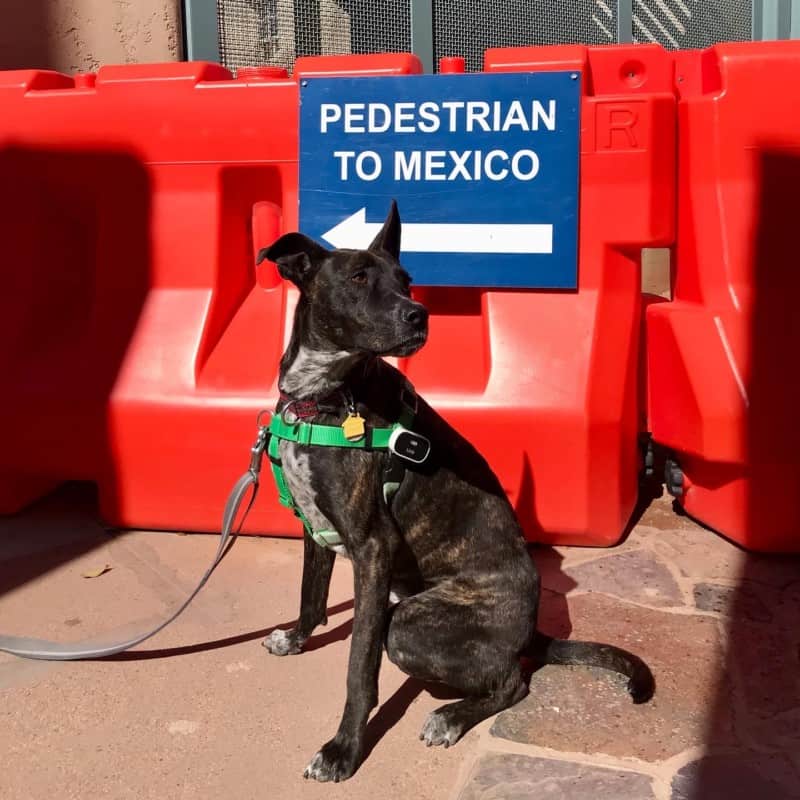
The rules for traveling to Mexico from the U.S. with a dog changed in 2019. If you’re planning to head south of the border with your pup, these tips will help make your trip a success!
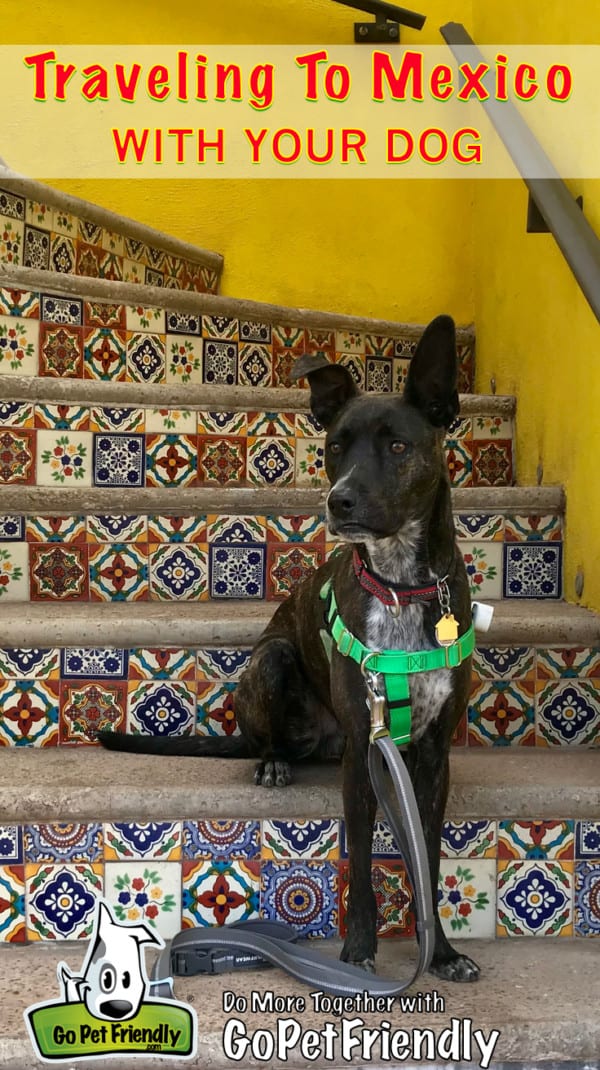
Whether you’re walking across the border for the day or planning a longer trip to Mexico, there’s no reason to leave your pup behind! The rules for traveling to Mexico with a dog changed in 2019, and it’s now easier than ever to take your furry travel buddy along.
But remember, it’s just as important to get back into the United States as it is to get into Mexico! So be sure you’re prepared for crossing the border in both directions.
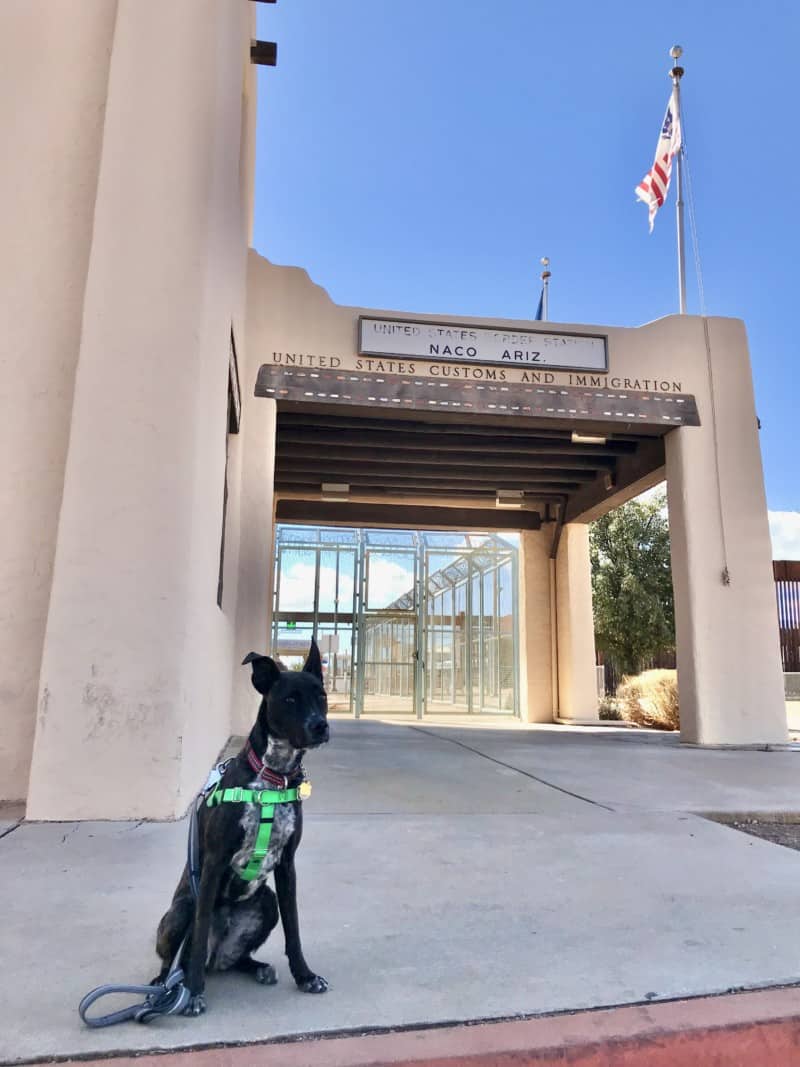
Traveling To Mexico With A Dog
Your experience crossing the border will be very different depending on how and where you travel. More scrutiny and inspections are common at busy crossing like San Diego and El Paso. If you’re flying in, your documents will also be reviewed more thoroughly.
In contrast, if you’re walking across the border, the process could be very casual – especially if you’re visiting a small town. Driving across the border will likely be somewhere in between, with where you choose to cross having the biggest impact.

What People Need
Mexico requires all foreign citizens visiting the country to fill out an Official Entry Immigration Form , also called a tourist card, prior to their arrival. Tourist cards are free and you can fill out and print the form at home .
When you arrive at the border, present the immigration officer with your printed tourist card and your passport. Since your information will already be in their system, once your tourist card is stamped, you’ll be off to enjoy Mexico!
If you are walking across the border into Mexico, you might find the immigration officer doesn’t request your tourist card. Still, it’s better to have it prepared – just in case.
Auto Insurance
If you are driving in Mexico, you will also need to purchase Mexican car insurance . Even if your U.S. auto insurance policy covers you in Mexico, it cannot pay damages that you would legally owe to others if you were in an accident. Mexican law is very clear—in order to drive in Mexico, you must at least have Mexican liability coverage, underwritten by a Mexican carrier.

What Dogs Need
On December 16, 2019, the United States Department of Agriculture announced that cats and dogs traveling to Mexico from the U.S. no longer need a health certificate.
The rules now state that travelers with the pet dogs and/or cats must visit the Mexican Animal and Plant Health Inspection Office (OISA), and see the person working with SENASICA upon arriving in Mexico.
If you travel regularly between the U.S. and Mexico with your dog, you can request to register in the “Pet Program – Frequent Traveler.” For further information, refer to the USDA website .
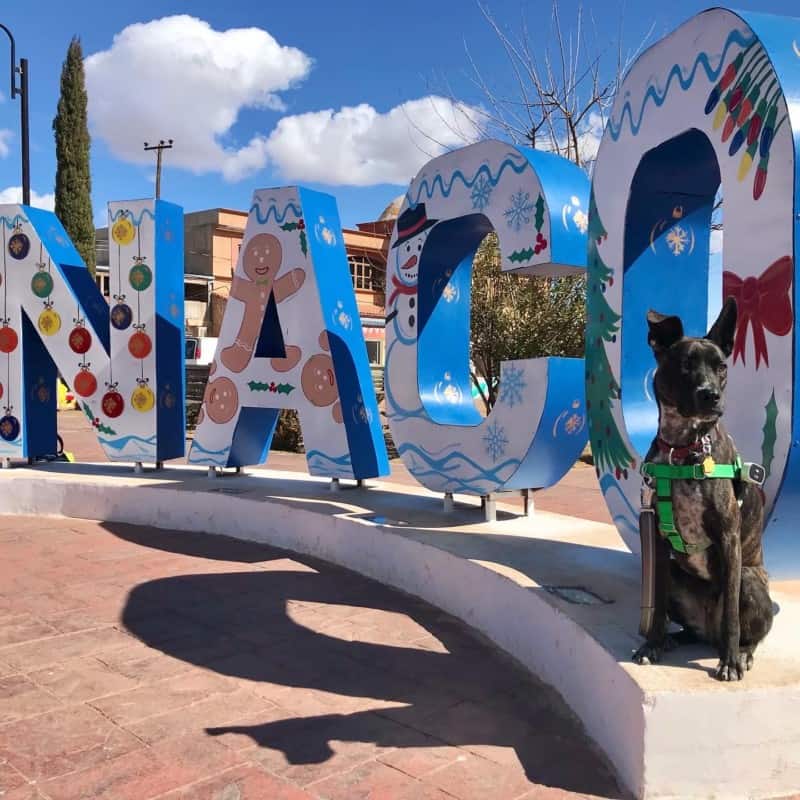
Pet Inspections When Entering Mexico
SENASICA inspectors aren’t present at every crossing. When we walked into Mexico from Naco, Arizona near Bisbee , there was no pet inspection. Myles simply strolled across the border with us.
READ MORE ⇒ Travel Guide: Pet Friendly Bisbee, Arizona
If there is a SENASICA inspector at your crossing, the rules state that pets must be presented clean cages or carriers. Though, we’ve heard this rules is not always enforced – especially for larger pets. If you cannot easily carry your pet in a carrier, presenting your dog on leash should be fine.
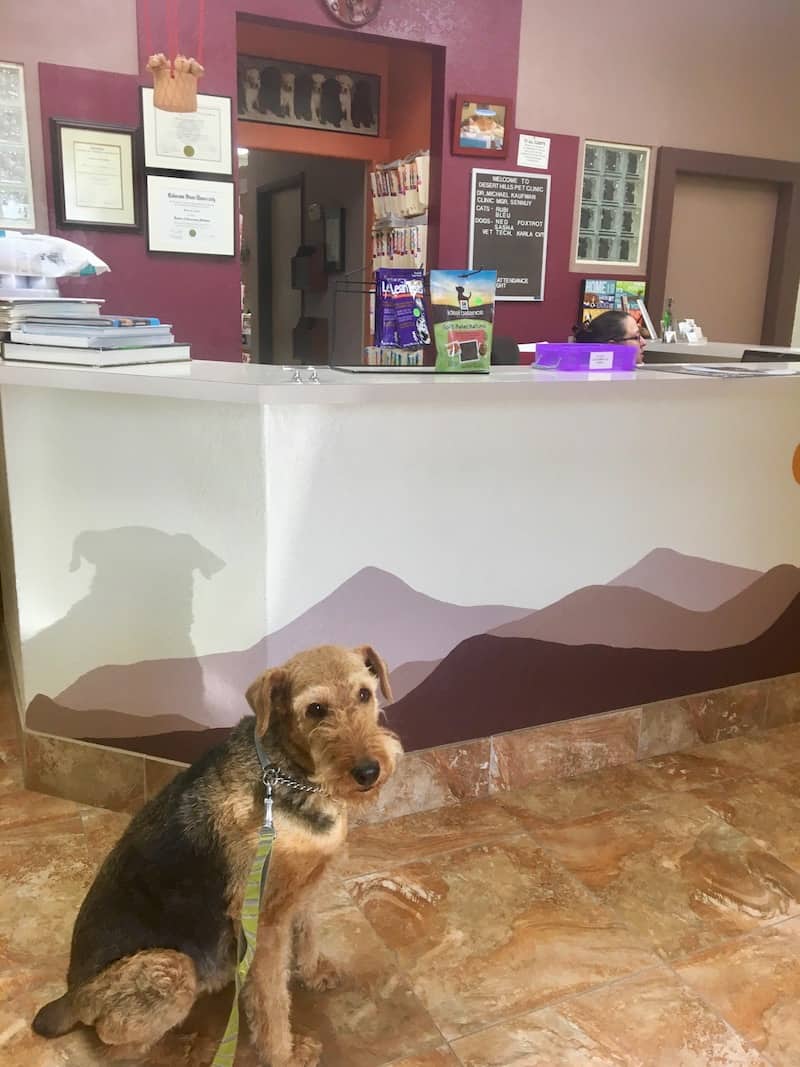
The SENASICA agent will perform a physical inspection of your pet to determine the following:
- Your pet shows no sign of infectious and contagious diseases,
- is free of ectoparasites (ticks), and
- has no fresh wounds or wounds in the process of healing.
If ticks are detected, your pet cannot cross the border. You’ll either need to return to the U.S., or the SENASICA agent will send a sample of the tick for diagnostic testing at the official laboratory. Your pet would have to remain at the OISA (Mexican official office) until confirmation is received that the parasites are not exotic/foreign to Mexico.
What If Your Pet Has Health Issues?
If your pet is being treated for lesions and/or infections due to a skin condition, present the SENASICA agent with the diagnosis and treatment instructions from your veterinarian. This information should be presented on letterhead, including the veterinarian’s professional registration number (or equivalent).
Can You Bring Pet Food Into Mexico?
When traveling to Mexico with a dog, the rules state you can only bring enough food to feed your pet that day. If you’re staying longer than a day, you could purchase pet food in Mexico. Or, consider shipping your dog’s food to your destination so it’s there when you arrive. Otherwise, you might be sharing your meals!

Something To Consider Before Traveling To Mexico With a Dog
In Mexico, we’ve found people to be very friendly toward Myles. Shopkeepers are generally less fussy about letting animals in stores, so traveling with a dog is pretty easy.
However, in Mexico and other Latin countries, you will often see dogs running loose in the streets. Generally, these dogs keep their distance. But if you have a reactive dog, this can be a stressful experience.
READ MORE ⇒ Tips For Traveling With A Reactive Dog
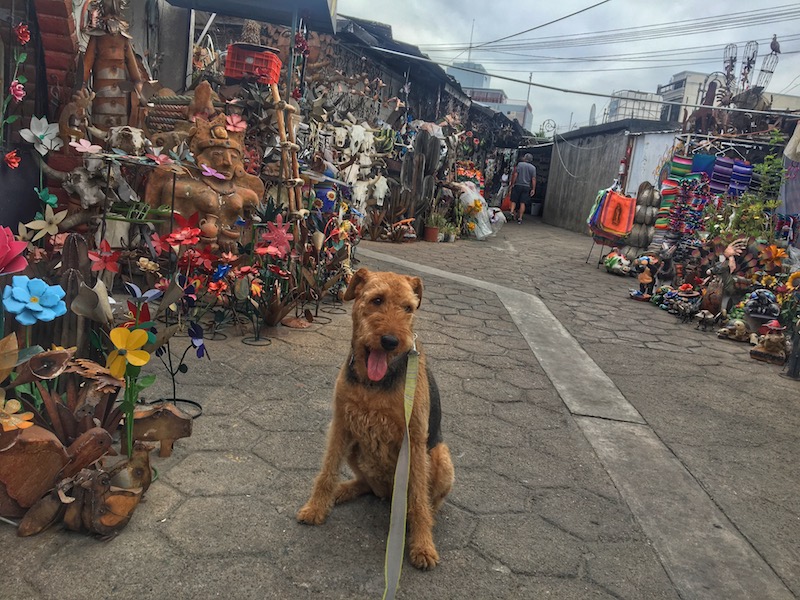
Returning To The United States
When you return to the United States from Mexico, U.S. citizens need to show a valid passport. If you are traveling by foot or car, you can provide a U.S. Passport card . This is a less expensive alternative to a full passport. But it only works for land and sea travel from Mexico, Canada, Bermuda, and the Caribbean.
Your dog needs less documentation to return to the U.S. than you! The CDC does not include Mexico among the list of countries considered high-risk for rabies.
So proof of vaccination is not required for dogs coming to the U.S. from Mexico, as long as your dog has not traveled to a high-risk country in the past six months. You’ll just need to provide a written or verbal statement your dog has only been in a country NOT at high risk for rabies for at least 6 months or since birth for puppies less than 6 months of age. And there is no limit to the number of dogs you can bring, as long as they are your personal pets.
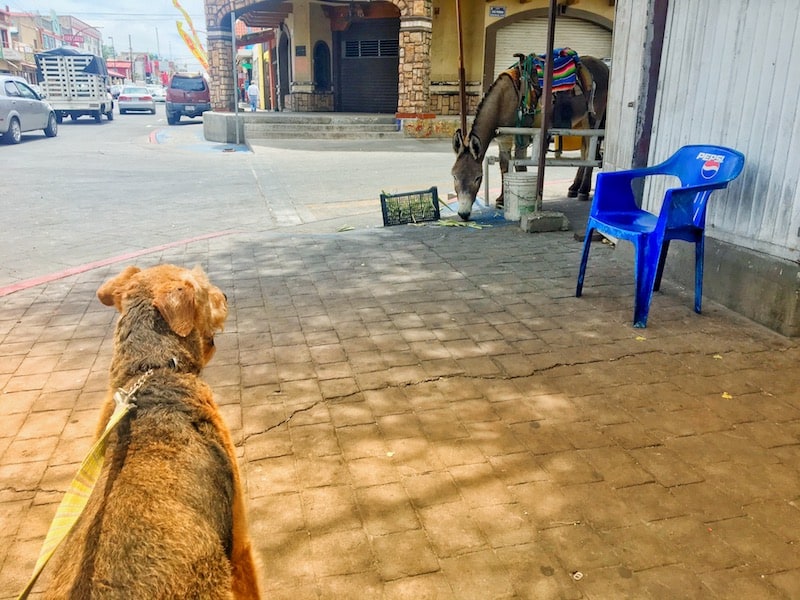
Have you taken your dog to Mexico? How was your experience?
Amazon Affiliate Disclosure: GoPetFriendly.com LLC is a participant in the Amazon Services LLC Associates Program, an affiliate advertising program designed to provide a means for website owners to earn advertising fees by advertising and linking to amazon.com, audible.com, and any other website that may be affiliated with Amazon Service LLC Associates Program. As an Amazon Associate, the owner of this site earns a commission from qualifying purchases.
We just returned from spending an afternoon in Agua Prieta, MX with our dog. We walked across from Douglas, AZ near Bisbee where the infamous Myles & Maynard of Go Pet Friendly fame live. Thought I would share our experience. Crossing in to MX and returning back to the US was a piece of cake! No one asked a single question about the dog. Surprising. The only thing they did was ask me to do was remove his pillow from the pillow case as we crossed in to MX. He’s almost 19 yrs old so we travel with a giant wagon/stroller and there is a human pillow in the bottom. We knew a health certificate was no longer needed due to law changes a few years ago. We had his vaccination records with us just in case, but no one asked. We carried in extra water for him as we didn’t want him (or us) drinking the local water of course. Since we were only there for a few hours we didn’t take any food. My research I believe indicated you are only allowed to bring 1 days worth of food with you even if crossing for a longer period of time? The only “issue” we had was finding a pet friendly location to eat other than the numerous food trucks found in the Central Plaza district. There are tables & chairs in the plaza if you want to eat at one of the food trucks, but we wanted a local restaurant with some personality. We ended up at Mia Burrito (corner of Av 11 & Calle 7). Local burrito stand with a few seats at the outside bar (with shade) & a bathroom in their back kitchen if you ask nicely. Human bathrooms were nearly impossible to come by….fyi. We each had a burrito & a soda. Total was $9. The dog enjoyed tortillas. We had wanted to eat at Bizio Cafe. However, they were closed due to construction. They too have outdoor seating with shade and are pet friendly. As we were walking back towards the border entry we stumbled upon what would have been exactly what we were looking for restaurant wise. La Rueda is the name and it’s on the same street before you get in line to re-enter. Outdoor shaded seating. Street dogs in A P were almost non existent. Different than other parts of MX we’d been to. We encountered 2 street dogs and both just ignored our dog. We walked the streets before & after lunch and then easily crossed back in to the US. Again, no questions asked. The hardest part of the return was getting his huge wagon thru the 2 turnstiles at customs. Where to park? You can park at the Douglas visitor center, but that’s a bit more of a walk. Put Douglas, AZ Walmart in your GPS. Park in that vicinity. There is a large parking lot across from Walmart with an abandon store front. That was were someone suggested we park. However, we ended up parking a few blocks closer to the port of entry near Dollar Tree. There was a strip mall where the store fronts were not yet finished. There were other cars parked here that appeared to have been from people walking across as well. A quick/short walk to border entry. Was there much to see/do? Nope. Exactly as we had expected. It was something we did more for the experience. Eat a good meal. Support the economy. Get our exercise walking for the day. Make some more memories with our Chuckie The Travelin’ Adventure Dog! Hope this helps anyone else considering crossing with their dog.
How wonderful! Thank you for sharing your experience, Cheri. I’m so glad to hear that crossing to AP is so easy. We’ve been across the border to Naco with Myles, but we haven’t gone to Agua Prieta yet. It sounds like we’ll have to give it a try!
I am planning a trip to Mexico next year. My dog is 60 pounds would I have to put her with luggage?? That’s scary if so. Advice anyone?
Hi Kimberly! Thanks for your note. As far as I know, there are no airlines that allow a 60-pound dog in the cabin. So your pup would have to travel in the cargo hold if you fly. I’m not sure how far you’re traveling, but driving is the only other alternative that I’m aware of. For your reference, the airline pet policies are all provided in this blog post >> https://www.gopetfriendly.com/blog/airline-pet-policies/ Good luck!
Try flying JSX. Will cost more and you may need to drive to a city with a non stop flight, but your dog can buy the seat next to you.
I’m flying with my dog as carry on. Taking two different airlines. Both airlines United and American require heath certificate and vaccination certificate to Mexico and returning to California. The carrier that goes under the seat for United is 17” long, 11” wide. 10.5”high for soft carrier. American Airlines lines is 18” long, 11”wide, 11”high. Different size requirements for hard carrier. Both airlines charge a Fee of $125.00. United allows the pet carrier and one personal carrier on bag. AA said the pet carrier is the only carry on allowed. I bought one of the cross bags that that I can keep my personal items in. My dog carrier converts to a backpack and standard carrier.
Hi Lori! Thanks so much for sharing your experience. I hope you have a fantastic trip – safe travels!
Hi thanks for sharing your experinec. Could you please share you carrier ? I have a medium size dog 22-25 lbs
Hi T! I don’t know if you’ll hear back from Lori, so I wanted to share this post we wrote recently about crash-tested dog carriers. Hopefully it helps and you have a great trip! >> https://www.gopetfriendly.com/blog/crash-tested-crates-and-carriers/
I need to state that my travel is exclusively at international airports, not border crossings. For the poster coming from Texas. Save yourself the anxiety…we have travelled internationally to Mexico, Nicaragua, Belize, Honduras. Get your vet to compose a letter stating your pet is in health and free from parasites. Then pack a dose of the meds you use, complete with packaging and keep it near your paperwork as proof. I have actually had the vets office compose a letter after they administered the meds, signed by vet…yes 3 originals The Mexican inspectors could ask you to dose your pet on inspection.I ALWAYS have a minimum of 3 originals, signed by vet, in BLUE ink, as they might want to retain 1-2 copies. Make sure your rabies vaccine is up to date…they now accept the three year vaccination. It must be administered at least 30 days PRIOR to your trip if you are nearing end of your rabies coverage. Once again 3 original copies signed by your vet. See where we are going. I keep a record of all my recent visits, just in case. Put paperwork in a designated folder. If you overdo it, you can’t go wrong, but never have a been questioned in all my trips. Sorry, don’t know about crates. Good luck, after this trip you will be a pro!
I’m driving from Texas into Mexico in October 2022 and will be staying 6 months. There is so much conflicting info out on the web.about what I have to have to cross the border. Can you confirm that I don’t need to pay for a vet’s health certificate. Do i need to bring their medical records with proof of vaccinations? Is rabies the only required vaccination? Do you have to show proof of deworming? Do they have to be in a pet carrier when they cross the border? Any information you could provide or confirm would be greatly appreciated. Thanks.
You need a valid rabies certificate with your dogs microchip in order to return to the US . This is very strict and more research should have been done before writing this article.
Hi Cindy. Your statement would be true only if the dog had traveled to a “high-risk country for dog rabies” in the past 6 months. Mexico is NOT on the list of high-risk countries provided by the CDC.
Per the CDC website: “Dogs that have NOT been in a high-risk country in the past 6 months are NOT required by CDC to present a rabies vaccination certificate. However, when you enter the United States, you must provide a written or verbal statement your dogs have NOT been in a country that is high risk for rabies within the last 6 months or since birth if under 6 months of age. While CDC doesn’t require proof of rabies vaccination, CDC recommends that all dogs be vaccinated against rabies, and your US destination may have additional requirements.”
Here’s the link if you’d like to research it yourself >> https://www.cdc.gov/importation/bringing-an-animal-into-the-united-states/dogs.html
I hope that helps clarify things!
Cindy, your statement is incorrect. I have also researched this topic myself and found it to be accurate based on the USDA and CDC website. The requirement for proof of vaccinations and health certificates has been suspended since 2019.
Thanks, Jack! It’s always good to have someone double-check.
You do NOT need a microchip. I have had 3 trips with my service dog and I’m in Mexico at present. You DO need a valid rabies certification( 3 originals per visit…they retain one copy at inspection). I have my vet sign a letter stating dog is in good health without sign of flea or ticks( 3 original copies). My trips are less than 30 days. Perhaps pet travel is different than service dog travel. Never have I had to prove he has a chip.
When you return to US do you need letter from Mexican veterinarian stating dog is in good health without sign of flea or ticks plus has not travelled to high rabies country? What do you actually need to return back to US. Thank you.
Hi Maria! Thanks for your note. As long as your pet appears healthy, you don’t need any documentation to cross the border from Mexico to the U.S.:
“Proof of vaccination is not required for dogs coming to the U.S. from Mexico, as long as your dog has not traveled to a high-risk country in the past six months. You’ll just need to provide a written or verbal statement your dog has only been in a country NOT at high risk for rabies for at least 6 months or since birth for puppies less than 6 months of age.
I hope that helps and wish you safe travels!
That’s pretty informative, didn’t know that they carefully examine dogs when entering the border, there were probably a lot of precedents for that to be enacted. How does one just stroll/walk towards the border?
Hi Terrier Hub! I think the level of scrutiny depends on the location of the crossing. We’ve parked on the US side of the border and walked across a couple of times and no one examined our dog, Myles, at all.
I have 2 cats & 2 dogs- is that a problem to cross the border?
Hi Anabel! Thanks for your note. Unfortunately, the regulations for crossing into Mexico are a bit murky. There is one source that says only two pets can cross with you for free and there is a charge for additional pets. But in other places there is no mention of a limit on the number of pets allowed to cross with no fees. My feeling is that you’ll be fine crossing with your two dogs and two cats, and I’d love if you’d send a note and let us know how the crossing goes!
Help! I have a small (22 lb) dog who will not fit as carry on. None of the airlines seem to be transporting pets as cargo. I need to get from Baltimore-Washington area to Cancun with my dog. Anyone have any ideas?
Hi Scott! My suggestion is to reach out to the folks at PetRelocation.com. They help people move with their pets all over the world and should be able to help you find a solution. Wishing you the best of luck!
I love traveling with my dog to Mexico “Avi Kerendian” he enjoys it a lot!
That’s wonderful! Thanks for sharing, Avi. And waggin’ trails to you.
Hello. I’ll be flying JetBlue from New York to Cancun and then back from Cancun to Newark New Jersey. I know Mexico doesn’t require a health certificate but I am worried about coming back to US (New Jersey). I called the New Jersey department of health of agriculture and they said a health certificate and rabies certificate is required. My only question is, does the health certificate have to be endorsed by the USDA/APHIS (this process takes weeks and there’s extra work and fees involved). I know LEAVING the U.S, this is required to enter some countries. I don’t know how it works with coming back….
Hi Sunny! My guess is that a health certificate from a veterinarian is all that’s required. But that’s only a guess. To be absolutely sure it would be best to call the New Jersey Department of Health and Agriculture again and verify their requirements. Good luck and safe travels!
We will be going to Puerto Penasco with our 2 dogs for a long weekend. I am very concerned about not being able to bring enough dog food as the closest store to where we are staying is 30+ minutes and we have small children to trek there as well. Are they very strict about the food allotment?
Hi Stacy! From what I’ve been able to gather from people who have crossed the border with pets and reported back, the level of scrutiny really depends on the location that you cross the border. The big, popular crossing are more strict, and the smaller, quieter crossings generally garner less attention. I’m sorry I can’t give you a more definitive answer. I hope your trip goes well. And please come back and let me know so I can pass the information along to others!
I’m Mexican and use to travel with my dog. Mexico is the worst! Even if I’m enroll in the Pet Travel Mexican Program ( SENASICA ) is like Passport but the authorities are not familiar with their own program. Always carry Health Certificate even if is nor required. Food even if you are allow for the day if you get with a non informed authorities the take it away. You can not ship any kind of food if is not approve for the authorities. Better be inform what you can get in Mexico and try to feed your pet with the same in your place. Be very careful where you dog sniff. Dogs get poisson in parks often. Leash always and id. Have handy a list of veterinarians in the area.
Thank you so much for sharing your experience, Azul! You’re the first person I’ve heard report these types of challenges. I hope the authorities become more familiar with their program and that crossing the border is easier for you in the future. Safe travels!
Condo rented in Mexico and pre paid, would not give us our room key with the service dog. Terrible experience. They didn’t care about certificates, SD vest, etc.
I’m so sorry you had this experience, Toni! I do know that the Americans With Disabilities Act, which covers service dogs, only applies in the United States. Though other countries have similar laws, their requirements are different than here in the States. It poses an additional challenge when traveling abroad with a service animal, and I appreciate you for sharing your experience and highlighting the issue for others in the same position.
Hi! Do you know if there is a limit to how many dogs can travel with you in a car? Also, did you have to have a crate for your dog when traveling by car?
Hi J! We’ve seen conflicting information about the number of pets. Most of what we’ve seen says there are no limits, but one resource said two pets. Also, though they say crates are required, the people who’ve crossed the border and shared their experience have said crates weren’t required.
I’d like to be more definitive, but the information from the Mexican authorities is somewhat incomplete. I hope it’s helpful to you and that you have a safe and fun trip!
thank you, this was very helpful ! I’m wanting to fly with my small dog to los cobos, mexico. So I should just be prepared for them to do an inspection of her, close by the airport? I have all her records and shots.
Hi Dede! Thanks for your note. These guidelines are for people driving across the border to Mexico. Since you’ll be flying, I’d recommend checking with the airline to find out their requirements. They’ll likely request more documentation that if you were driving. Good luck, and safe travels!
How was the airport inspection? Have you gotten back yet? How was that process, if so?
How many dogs per person are you allowed to bring into Mexico? There will be two of us traveling with three small breed dogs
Hi Heriberto! In the most recent requirements provided by the Mexican government, there is no mention of a limit on the number of pets you can take across the border. You should be fine with your three dogs. Safe tavels!
We are in Mexico with our yorkies. We brought 2 bags of dehydrated raw. They seemed to care if it contained beef. The vet in Melaque sells dog food so you should be able to get yours in any bigger city.
Thanks so much for letting us know, Susanna! It’s good to hear from people who’ve been through the process. Safe travels to you!
I’m sorry, Grizz, but I don’t have the answer to your question. I suspect that the location of the OISA changes depending on where you cross the border. Safe travels to you!
I have flown into Mazatlan several times with my old puggle. The first two times a US Dept. of Agriculture certificate was required. I had to produce it in the luggage arrival area and was ushered over to a corner where the Mexican SENESECA or whatever they’re called inspector came around and physically inspected my poor dog. He really seemed to be looking for something wrong with my documentation. I flew in again about 5 months later with the same paperwork, but reissued and updated, and he found fault with exactly how my vet had entered the info about the parasite medications on the certificate. After a big deal about it, he said he would “let it go.” After inspection, they give you a two ply paper and collect the top half as you exit with your luggage and your dog. You keep the second half for when you depart, they ask for it at the airline check in. The third time, in February of 2020, I asked my vet for a USDA certificate again; I was told none was needed anymore but I asked for one anyway. All the websites and all the info I had said no certificate was required, but when I got to the inspection area, the inspector insisted on seeing a USDA certificate. I told him I thought I didn’t need one. He said no, I did. He seemed crestfallen when I produced one, then began to examine my dog. She is 13 and and has two grape-sized breast tumors on her belly. The vet said the only way to know if they are malignant is biopsy and surgery, but the dog is too old for that and surgical intervention is unlikely to help her at this time, so we are leaving them. Well, that inspector started squeezing and pulling at my poor dog’s tumors in a rather perverse way and I had to tell him to stop it. He issued his two ply certificate anyway and we proceeded without further perversion. We are planning on driving to Puerto Penasco with the dog soon, and I am going to travel with a USDA certificate, even though they are $65 at my vet’s. If my dog’s two tumors become an issue I am turning around and going back to the US.
Thank you so much for sharing your experience, Florence. I’m so sorry that your poor pup had to endure what sounds like an uncomfortable examination! If you would, please come back and let us know how things go when you drive across the border – hopefully everything is smooth and easy. Safe travels!
So here I am with an update–I drove into Puerto Penasco with my old puggle recently. I tried to get a USDA certificate from my vet but couldn’t get an appointment, ultimately I decided to just travel with the old certificate I had from 2020 and her vaccination records. We went in a pick up truck with a crew cab, and I bought a dog carrier sling that goes in the back and rests on the two jump seats. There was only one lane to go through in Sonoyta, and the Mexican official motioned us over for further inspection. My husband is Mexican, and was driving, and the official asked him what we had in the back of the truck (which was covered with a tonneau top). My husband said would you like me to open it up, and the official said yes. So my husband got out, opened up the back of the truck, the guy just took a quick look, and told us we could go. He never looked in the back of the cab and he never saw the dog, nor did he ask for my tourist card. So then we were on our way, and I didn’t even see the SENESICA office or any other place where I would check my dog in. My husband was very much, “let’s go, let’s not make any trouble for ourselves” so we just drove on and didn’t stop anywhere. Returning to the US, the Customs and Border patrol saw the dog in the back but didn’t ask for papers which was a good thing, because I seem to have lost the dog’s papers while at the Puerto Penasco rented beach house!
I really appreciate you for coming back to share your experience, Florence. Thank you! And I’m glad to hear your trip went smoothly. Waggin’ trails to you all!
I’m going to be traveling to Puerto Penasco in my truck with my two large doodles (1 is 65lbs and the other is 90lbs). I saw something on the USDA website about all animals needing to be in a crate when crossing the border. Is this the case? It would be very difficult to find one that will fit both dogs in the backseat of my Tacoma. Please let me know any info regarding this. Thanks!
Hi Matty! Yes, I’ve seen some indications of crates being required on the website. But I’m hearing from people who’ve crossed the border that they didn’t have a crate and all was fine. I can’t say for certain, because each agent could feel differently about following the “letter of the law,” but I think if your dogs are well-behaved you’ll be fine. It also wouldn’t hurt to have them buckled into seat belt harnesses!
Okay thank you Amy! The seatbelt harness is a great idea just in case!
Hi! I will be flying into Cabo San Lucas in October with my dog. Will she be screened medically at the airport or will I need to take her to a vet seperately? Also, does she need the ectoparasite treatment prior to flying or is that no longer a requirement?
Hi Phyllis! Thanks for your note. Since they’ve changed the rules and then the pandemic hit, we haven’t had any reports of people’s experiences flying with their pets to Mexico. My advice is to call the airline – they might be able to answer your questions. Or check with PetRelocation.com. They help pets move with their families all over the world and might have more experience in flying to Mexico. I hope that helps and that you have a wonderful trip!
When is the pet examine done, at the border or do we schedule it for after we’ve arrived at out destination?
Hi John! My understanding is that it happens at the border when you cross. Though, depending on where you cross there might not be an exam at all. I’ve been hearing reports from people crossing the border that no exam was done. Hope that helps and that you have a great trip!
I just came back from Mexico thru Nogales border. Going into Mexico back in early December, there was no problem whatsoever. They did not even ask a single question about my dog. I had spent over $200 on vet bills to get all the shots he needed & the accompanying letter of his good health. On our return to the US, it was the same. No questions asked nor documents required by the inspecting border agent.
Thank you so much for sharing your experience, Mahmood! The new rules haven’t been in place very long, so hearing from people who’ve been across the border really helps. Safe travels to you!
Do you know if we need crates or carriers for our two dogs?
And do they provide visas at the border like they do when you travel by air? Or do we have to print them out beforehand? This is mine and my husband’s first time traveling to Mexico by car (and with pets), so we have no idea what to really expect.
Hi Kimiko! The rules say that pets must be in crates or carriers. However, I’ve been hearing from people who have crossed the border that they did not have them, and there was no problem. It may depend on where you’re driving across. Unfortunately, that’s the best information I have.
As for visas, my understanding is that you’re meant to complete the paperwork online and print it to take with you. Again, whether it is checked or not could depend on where you cross. I hope that’s helpful and that you have a great trip!
Hi KamikoK, I am going to be headed to Mexico from the US with my two pups in December. Did you find out about the crates? we dont have them and I would hate to buy them. But I am also terrified of not getting through. How was your experience? and where did you cross? we will be crossing from Laredo.
We crossed through Laredo also, and we did not have our dogs in crates. They didn’t even ask for any paperwork for our dogs. Very easy!
That’s great! Thanks so much for sharing your experience.
This makes me feel SO much better. Thank you!
We fly to Mexico frequently from California with our small ESA dog. All Mexican airlines have asked us for health certificates and we have always been stopped at customs in Mexico. 99% of the time we are delayed by either Mexican airline employees or Mexican custom officers. They check and re check and check again all of our paperwork. In fact on our most recent trip 11/2019 they asked for our paperwork six different times. I haven’t flown since the new law and am curious to see if the Mexican airline have updated their policies. I checked online and see that they still require health certificates.
Hi Adam! Thanks for sharing your experience. And yes, in almost all cases airlines require health certificates for pets that will be flying – even if they’re not leaving the United States. I don’t expect the airlines to relax their rules, but the documents required to drive or walk across the border are less. Safe travels to you!
I’d like to know more about the kennel/cage rule as well if anyone crosses in the next couple of days. We will be crossing in about a week and I would rather not buy a crate if it’s not necessary or enforced.
Unfortunately, the rules are so new (and not clearly written), so we’re still figuring things out too, Mikey. I wish I could be more helpful. Please let us know what you learn when you make the crossing!
I am in Mexico cureently, we crossed the border on Jan 7, which is after the rule change. we crossed at bridge #1? (the commerical bridge) in Eagle Pass TX/Piedras Negras. I crossed on foot with a bicycle and my dog. we did not have or need a carrier/crate. They also never had us do the inspection. I had his vac, de-worming, and flea and tick records. nothing was asked for. I asked the inspectors if they needed anything else for the dog and they said “no” and told the guy at the imss office I had a dog with me and he didn’t care. we have been in Mexico for a month and past through 4-5 police and army checkpoints and noone has cared about the dog or asked for any paperwork. this is just our experience and other crossings may be different but they didn’t care where we crossed.
Thank you so much for sharing your experience, Mikey! I hope you’re having a wonderful time on your trip. Waggin’ trails!
How many dogs can you bring to Mexico from USA. I’m asking because we have 5 healthy dogs and my husband and I plan to drive to Mexico City this year.
Hi Tanya! I can’t find any limit on the number of dogs that you can take across the border, as long as they are your personal pets. I know that when crossing between the US and Canada there is no limit. I hope that helps!
This is great, the changes — thank you so much for posting. I wonder if Canada will be next in relaxing the pet entry rules. Hope so anyway.
Agreed, AH – that would be fantastic!
We are Canadians who also have a condo in the northern Baja where we have spent our last 12 winters. We cross the border (Mex/US) at least twice a month by car going into San Diego and always take our dog. I do carry her rabies and vacines certificate with us when we cross, but have never been asked for any documentation whatsoever when traveling by car in either direction. I am asked for the rabies certificate when entering the states BY AIR with her, (not by car) and also when returning to Canada by the Canadian officials when FLYING home.
Thanks so much for your note, Judy! We’ve found much the same when traveling with our dogs between the US and Canada – our paperwork is rarely checked. It is interesting to note that this new rule makes it clear that it’s the responsibility of the person crossing into Mexico with a dog or cat to visit the OISA office for an inspection of their pet. And there is no word on what the penalty for not doing the inspection will be.
Make sure to subscribe to our newsletter and be the first to know our latest news and pet friendly activities.
Travel Inspiration
National parks, hit the beach, mountain getaways, cities to explore, iconic road trips, unique attractions, related posts.

Session expired
Please log in again. The login page will open in a new tab. After logging in you can close it and return to this page.
We know you’re excited to travel!
In order to save your trips and favorite destinations, you need to set up an account or login .
By creating an account you agree to our Terms & Conditions
Thanks for joining GoPetFriendly!
Please check your email to confirm your registration

Don't have an account? Join Now!
Sorry we can't find any pet friendly listings in our database. Please make sure your search is spelled correctly or try typing fewer characters. nearby ! -->
Do you know of a pet friendly place here? Let us know.
- Share full article
Advertisement
Supported by
Flying With Dogs or Cats? These Are Airlines’ Pet Policies
American recently relaxed its rules for pets traveling inside the cabin with their owners. Here’s what the major U.S. airlines require to travel with a pet.

By Jesus Jiménez
Flying with a pet can be expensive and confusing, with fees, weight limits, carrier size rules and the need to make sure there’s no loud barking (or meowing) on board.
Recently, American Airlines relaxed its pet policy to allow passengers to bring a carry-on bag in addition to a pet in a carrier, and more private flight options have been emerging in recent years for pet owners who can afford them.
Still, flying with large or medium-size dogs can be tricky, and many travelers are wary of leaving a pet in the plane’s cargo hold.
For those traveling on the major carriers with their pets as carry-ons, here’s what to know about each major domestic airline’s policy.
Southwest Airlines
On Southwest, a Dallas-based carrier, two checked bags can fly at no cost, but not pets. Southwest charges $125 per pet carrier on its flights.
Dogs or cats are allowed to travel below a seat in an approved carrier — up to 18.5 inches long by 8.5 inches high and 13.5 inches wide — according to the airline .
Southwest has a few caveats for those traveling with pets: The pet must stay in its carrier during the flight, and the carrier is considered a personal item or carry-on bag.
Up to six pets are allowed on Southwest flights. Once six pets are booked onto a flight, no further customers may add a pet companion to their booking.
United Airlines
United Airlines has no weight or breed restrictions for cats and dogs as long as they are in an approved hard or soft-sided carrier, measuring 17.5 inches long by 9 inches tall and 12 inches wide for a hard carrier, or 18 inches long by 11 inches tall and 11 inches wide for a soft carrier.
United charges $125 each way for travel with pets. There is no fee for service animals on United flights, but some forms are required before the flight.
The carrier must fit under a seat, and where a passenger is allowed to sit can vary according to the type of aircraft. For example, people traveling with pets cannot sit in emergency rows. If you’re traveling with two pets (the maximum allotted), you are required to book two seats.
Delta Air Lines
Small dogs and cats can travel on Delta Air Lines flights as long as they can fit inside a carrier stored below the seat. The size of the carrier depends on the aircraft, but in general the airline recommends a soft-sided carrier no larger than 18 inches long by 11 inches tall and 11 inches wide.
Your pet must be at least 8 weeks old and small enough to have some room to move around in the carrier, which must have ventilation openings on three sides.
Delta charges $95 for pets traveling as carry-on companions, and the passenger can bring only one personal item along with the pet. Certain seats cannot be booked for travel with an animal, such as those in an emergency exit row.
American Airlines
American Airlines allows cats and dogs to travel in a carry-on container, which must remain under the seat in front of the pet owner throughout the flight. The airline recommends a soft-sided carrier that measures 18 inches long by 11 inches tall and 11 inches wide.
The fee for a carry-on pet on a domestic American Airlines flight is $150.
Flights are limited to seven carry-on pets, not including service animals, and American Eagle flights are limited to five carry-on pets, with one in first class. There is no charge for service animals flying on American flight, but the airline requires forms to be filled out in advance.
The airline said in a statement that it had recently changed its cabin pet policy to allow customers with a pet to also bring either a personal item or carry-on bag stowed in the overhead bin (but not both).
“We made the change to provide a more convenient and comfortable experience to customers whose pets fly American,” the airline said.
Spirit, JetBlue, Frontier and Alaska
Spirit allows dogs and cats on its flights in a carrier no larger than 18 inches long by 14 inches wide and 9 inches tall for a fee of $125. The weight of the pet and the carrier cannot exceed 40 pounds, according to the airline .
Small dogs and cats can fly on JetBlue for fee of $125 each way , in an approved carrier. Up to six pets are allowed on JetBlue flights.
Frontier allows pets on board for a $99 fee each way, as long the pet fits in a carrier. Passengers can have only a personal item or carry-on in addition to their pet carrier.
Pets can travel in a carrier on Alaska Airlines flights for a fee of $100 each way. A passenger can travel with a pet carrier and a personal item, or a carrier and a carry-on bag.
Private or charter flights
Those who take their pets on private or charter flights, which can cost many thousands of dollars, have much more leeway. Dogs that weigh less than 150 pounds can sit on seats.
BarkAir, a charter operator tailored specifically for those flying with dogs, charges about $6,000 for a dog and its owner to travel, with flights between New York and Los Angeles and New York and London. Carriers are not required, and dogs can sit on laps, seats or beds.
Jesus Jiménez covers breaking news, online trends and other subjects. He is based in New York City. More about Jesus Jiménez
Open Up Your World
Considering a trip, or just some armchair traveling here are some ideas..
52 Places: Why do we travel? For food, culture, adventure, natural beauty? Our 2024 list has all those elements, and more .
Mumbai: Spend 36 hours in this fast-changing Indian city by exploring ancient caves, catching a concert in a former textile mill and feasting on mangoes.
Kyoto: The Japanese city’s dry gardens offer spots for quiet contemplation in an increasingly overtouristed destination.
Iceland: The country markets itself as a destination to see the northern lights. But they can be elusive, as one writer recently found .
Texas: Canoeing the Rio Grande near Big Bend National Park can be magical. But as the river dries, it’s getting harder to find where a boat will actually float .


How To Travel To Mexico With Your Dog: A Complete Guide

About the author
Alex Gomez, the founder of Mexico Travel Buddy, combines his firsthand, on-the-ground experiences in Mexico with a personal connection to the country, fostered through his Mexican wife and numerous explorations. More info
I have always wanted to travel to Mexico with my dog, but I was curious what it actually takes to get them there. So, I did some in-depth research and here is what I discovered.
What You Need In Order To Travel To Mexico With Your Dog
In order to travel to Mexico with your dog, a health certificate is no longer needed. However, your dog needs to be in a clean, approved carrier, and you will need to visit the Mexican Animal and Plant Health Inspection Office (OISA) to contact the appropriate employee working with SENASICA. The office worker will check for the following on your dog:
- Your dog does not show signs of infectious and contagious diseases
- Your dog is free of ectoparasites (ticks and fleas)
- Your dog is free of any open and healing wounds
If your dog does happen to have parasites, you will need to contact a veterinarian to receive the appropriate treatment. If ticks are detected, the employee will take a sample of the ectoparasite, and send it off to the official laboratory for further testing. As well, they will verify that all parasites are removed from your dog.
Your dog will have to be kept at the OISA official Mexican office until the lab concludes the parasites are not foreign to Mexico. If so, SENASICA ultimately decides what steps to take next. Any expenses that may arise such as veterinarian costs, are expected to be paid by you (the importer).
If your dog is currently going through treatment for lesions or infections on the skin, you must bring a Veterinarian’s results and treatment in letterhead, along with their professional registration number.

It’s very important that the carrier your dog arrives in, is clean. Anything that is inside the carrier will be tossed out. If your dog has a favorite toy, don’t put it in there. A disinfectant will will be applied on your carrier, but this is expected.
NOTE: If traveling to Mexico with your dog on an airplane, airlines may have their own policies and requirements that you will need to adhere to; separate from your destination requirements.
See also: Planning Your Perfect Wedding In Mexico: Everything You Need To Know
Bringing Your Dog’s Food To Mexico
As far as bringing your dog’s food to Mexico, that a big no-no . You can only bring the amount of food your dog will eat on the day of arrival. Any additional food will be discarded.
Depending if you are heading to a large or small city in Mexico, they may or may not carry the brand of dog food your dog is use to eating.
If you are planning on staying in Mexico for at least a few weeks with your dog and you want to buy the correct dog food , just order it on Amazon.com and have it shipped to your location in Mexico.
The Cost To Fly Your Dog To Mexico
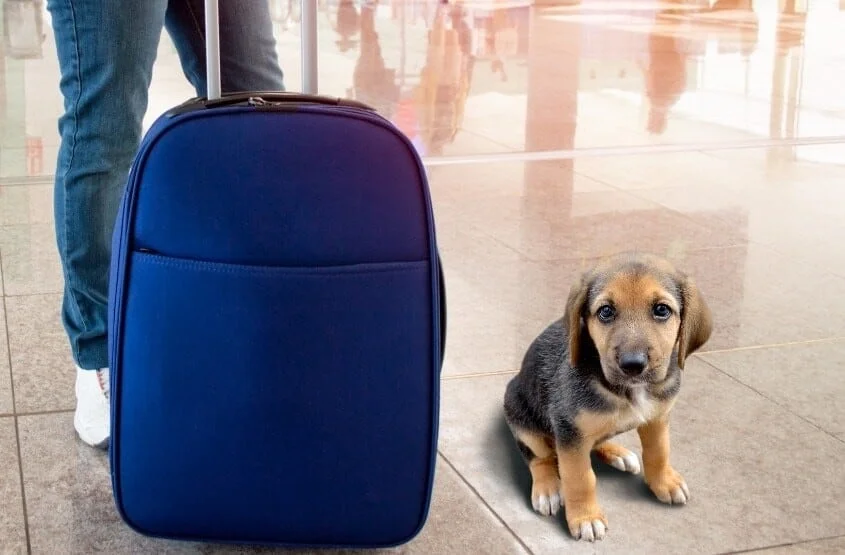
The average fee for a one-way flight to Mexico for your dog, ranges from $99 to $125. That does not include potential additional fees such as veterinarian costs; dog food, and an airline accepted pet crate, for a total ranging anywhere from $350 to $650 for a round-trip flight for your dog from the U.S. to Mexico.
These are rough estimates and greatly depend upon what you still need for your dog. If your dog is a registered service dog, the flight fee is usually waived, potentially saving you hundreds of dollars.
If you already have a pet crate that is acceptable for the airline you are flying with, then you save yourself another $50 to $150. So you may end up only spending money on your dog’s food and veterinarian costs, which can range from $50 to $100.
See also: Mexico Travel Insurance: Is It Worth It
However, if you’re anything like me and you still have to purchase everything for your dog before your flight to Mexico; expect to spend closer to the $500 to $600 mark for a round-trip flight for your dog.
Flying To Mexico With Your Dog
If you are trying to get to Mexico with your dog via airplane, this may require some additional documents and fees (ranging from $99 to $125 each way). Some airlines may require that your dog has a health certificate from a certified veterinarian to ensure that your dog is in good condition for flying.
Here is a list of airlines that currently allow dogs to fly internationally to Mexico, and which ones require a health certificate:
Flying With Your Dog In-Cabin
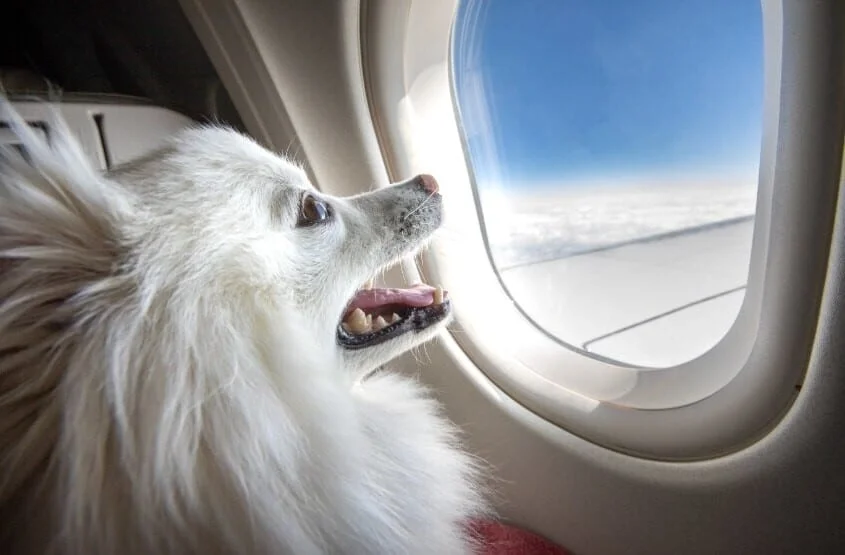
Many airlines will allow your dog to travel with you in-cabin however; there are strict requirements enforced by each airline.
Some things to take into consideration when flying with your dog in-cabin are your dog’s weight, the weight and type of carrier your dog is in, and the age of your dog (must be at least 16 weeks old for international flights to Mexico).
Here is the maximum weight and required carrier size for each airline:
When flying with your dog in-cabin, your dog must remain in its carrier at all times. The kennel must remain at your feet, under the seat in front of you.
See also: Top Mexico Travel Tips To Know For A First-Timer
As well, you are not able to sit in an emergency exit row if you have your pet with you as a carry-on, so check your seating arrangement to make sure this in not the case.
Flying With A Large Dog To Mexico
If you are flying with a dog that is either too heavy or too large, or maybe even both, you should consider checking your dog in with the luggage.
Your dog will then be placed in the cargo area of the plane, securely strapped down in its carrier. You must have your dog in a solid carrier that is approved for air transportation, each airline have their own requirements and limitations.
Here is a chart stating what each airline’s requirements and limitations are for checking your oversized dog in as luggage:
If you need to check your dog in prior to your flight, it is recommended that you show up 3-4 hours before your departure, this will allow you enough time to get everything squared away.
Is It Safe For Your Dog To Fly In Cargo
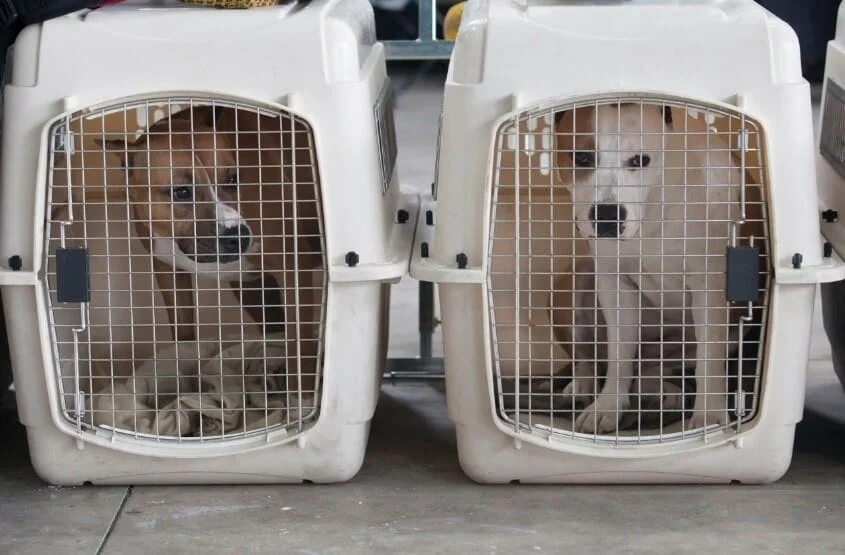
Overall, it is safe for your dog to fly in the cargo area of the plane. Your dog is required to be in a hard-shelled carrier with proper ventilation, which will be tied down to ensure minimal movement and sliding around.
Airlines will not load your dog in the cargo area if the temperature outside is lower than 45°F (7°C) or higher than 85°F (29°C) for safety reasons.
Make sure to go over this safety checklist, before checking your dog in with the cargo.
- Get a health checkup from a certified veterinarian 1-2 days prior to your flight
- Crate train your dog weeks prior; leading up to your flight
- Trim your dog’s nails before flying
- Ensure your dog has updated ID tags with your contact information
- Feed your dog 3-4 hours before your departure time; continue to give your dog water up until it’s time to checkin
- Try to book direct flights; avoid long layovers when possible
Getting a veterinarian to check your dogs health a couple days before travel is a good idea even if it not required by the airline. This way you can fly with a peace of mind, knowing your dog is in good health and has no pre existing medical conditions that may affect their flight experience.
While you are at the vet, make sure they trim your dog’s nails to help reduce the urge to scratch at their kennel during flight. Also, have your vet write up a proper feeding/water schedule for the day of the flight.
Moreover, it’s a good idea to crate train your dog, preferably in the same crate he will be flying in. This is especially true if your dog is not use to being locked up for longer periods of time in a kennel. I would start crate training at least 2 weeks prior to your flight date.
It’s important that your dog has proper identification with your current contact information attached to their collar, and even a tag on the crate isn’t a bad idea.
Although though your dog is required to be traveling on the same flight as you, this is good practice to ensure your dog reaches the destination safely and efficiently.
If at all possible, try to book your flight to Mexico direct from your original departure destination. If you can book your flight at a time of day where the temperature isn’t too hot 85°F (29°C) or too cold 45°F (7°C), this will ensure that your dog will be able to board the cargo area with no problems.
Generally, the longer your flight is and the more variances in climate change, the harder the flight will be for your dog.
Making sure to go over this pre flight checklist is very important to ensure your best friend is as comfortable and safe as can be on their flight to Mexico.
Flying To Mexico With A Service or Emotional Support Dog
When you are flying to Mexico with your service dog, airlines generally require the following:
- Registration letter/certificate for your service dog
- A medical health certificate from a certified physician; issued in letterhead stating you need to travel with your dog due to health issues (must have date issued, medical license number, and physician specialty license)
- A certificate of good health issued by a veterinarian (5 days from date issued) written on your vet’s letterhead with their license number. Letterhead must also include name and address of the owner; breed, gender, age, and color of the animal.
- Proof of rabies vaccination (no more than 3-years and no less than 30 days old) (dogs less than 3 months old are exempt)
If you are traveling to Mexico with your service dog, an advanced notice to your airline is encouraged but not required. However, if you are traveling with your emotional support dog, advanced notice and approval may be required before flights (provide notice at least 48 hours in advance).
Moreover, each airline will have different requirements when it comes to you and your service dog, so make sure to request everything that your airline will need well ahead of time.
If your service dog is too large to fit below you, or under the seat in front of you, most airlines will allow your service dog to be seated next to you on a separate seat as long as it is not assigned to someone else; generally at no additional cost.
If your dog is too large to fit on the seat next to you, or in the event that no extra seats are available for your dog, you may have to purchase a plane ticket for your dog, rebook on a flight with more available seats or, transport your dog as a checked pet.
All these options will most likely include an additional fee, so make sure to contact your airline as soon as possible when flying to Mexico with your service dog.
Feeding Your Dog Before Your Flight
It is important to feed your dog 3-4 hours before your departure time. Avoid feeding your dog right before your flight; as your dog may experience an upset stomach. Most airlines require you attach a small bag of dog food to the top of the crate with feeding instructions for the day of your flight.
I’d also recommend two travel bowls for your dog that are attached to the inside of the crate. This will allow the staff to properly provide food and water per your instruction’s. Most airline approved dog crates will come with travel bowls when purchased such as this one found on Amazon. (View airline approved dog crate)
Traveling To Mexico With Your Dog Often

If you travel regularly between the U.S. and Mexico with your dog, you can request to register in the “Pet Program – Frequent Traveler”. The purpose of this free program is to speed up the process for people who travel frequently to Mexico with their dogs.
Here are some advantages of joining the Pet Program – Frequent Traveler:
- Reduce your waiting time
- No need to submit another Health Certificate during 6 months
- Data record will not be necessary (will already be in the database)
- No need to wait for a hard copy of the Import Certificate (will be emailed to you directly)
- “Entry Record” will be granted nationwide at the Office of Agriculture and Livestock Health Inspection (OISA) and at SENASICA’s headquarters
For further information please visit GOB.mx .
Coming Back From Mexico With Your Dog
When bringing your dog back from Mexico to the U.S, it must appear healthy, to enter. A rabies vaccination certificate is not required by the CDC when traveling back to the U.S. from Mexico ( source ).
There should be minimal fees when bringing your dog back to the U.S. from Mexico either by car or on a plane. However, the same requirements from your airline stay true, whether you are traveling to or from Mexico with your dog.
Driving To Mexico With Your Dog
As of December 16th, 2019 dogs no longer need a health certificate when traveling to Mexico. Upon arriving at the Mexican border, your dog may be physically inspected by SENASICA. Again, the inspector will verify the following:
If your pup looks healthy, then you will be allowed entry into Mexico. One of the great things about driving to Mexico with your dog, is the fact that you don’t have to pay for the airlines fees or deal with the hassle of required dog crate dimensions.
Although, even if you are driving across the boarder, your dog still needs to arrive in a clean cage.
Remember, only bring the amount of food your dog is going to eat on the day you are traveling into Mexico. Any excess food will be thrown away upon entry into Mexico. You can purchase more food when your are in Mexico.
If you are staying at one location for a few weeks and want to order your dog’s specific food , you can most likely have it shipped directly to you from Amazon.
The Cost To Drive Your Dog To Mexico
The only expenses when driving your dog to Mexico will be the gas to get there, and a pet carrier (if you don’t have one). There are no additional fees for bringing your dog into Mexico by land from the U.S.
Be aware though, there are other expenses and documents that are required when driving a vehicle into Mexico, whether you have your dog with you or not. If you want to know exactly what you will need when driving to Mexico, you should checkout this blog: Traveling To Mexico By Car: Your Complete Guide .
Is It Safe To Bring Your Dog To Mexico
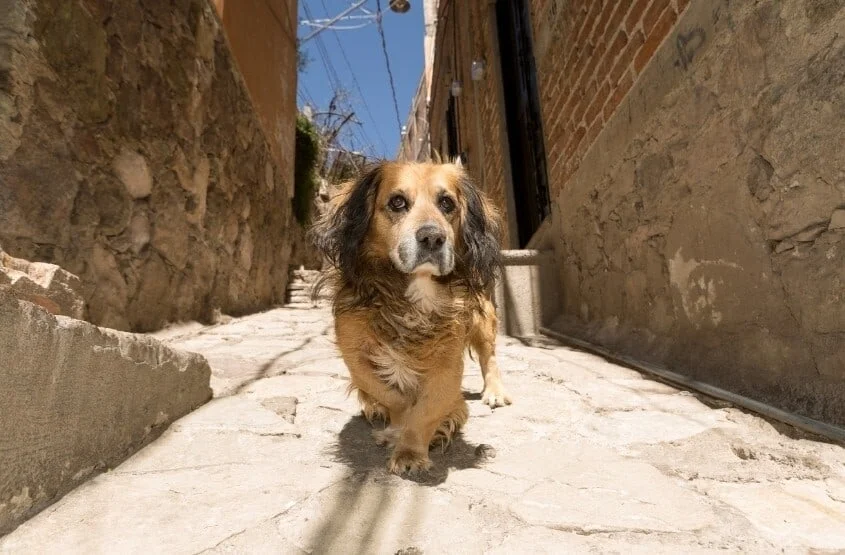
Overall, bringing your dog to Mexico with you is considered safe and a lot of people are doing it. Here are a few tips for keeping your dog safe when traveling around Mexico:
- Keep your dog hydrated
- Take your dog for walks early in the morning, or later in the day after the sun has set
- Avoid letting your dog eat trash and feces off the street
- Ensure your dog has a proper collar and updated ID tag containing your current contact info attached
- Try to feed your dog the same kind of food; don’t switch it up so often
- Avoid letting your dog mingle with any strays
Besides stating the obvious, your dog will most likely enjoy Mexico, just as much as you do.
Ultimately, if you are considering bringing your dog to Mexico with you, it will require some planning. But in my opinion, it is well worth it. I’ve noticed that a majority of people bring their dog to Mexico when vacationing.
After all, who wants to leave their best friend back at home?

Alex Gomez, the founder of Mexico Travel Buddy, combines his firsthand, on-the-ground experiences in Mexico with a personal connection to the country, fostered through his Mexican wife and numerous explorations. As a professional writer and avid travel enthusiast, his favorite destination remains anywhere within Mexico's diverse landscapes. His extensive travels have equipped him with a treasure trove of tips, tricks, and insights, which he enthusiastically shares with his audience. Alex's stories and photos on the website not only showcase his love for Mexico but also offer readers a deeply authentic and engaging perspective.
Read more by Alex Gomez
Leave a Comment Cancel reply
Welcome to mexico travel buddy.

We are excited to help you make the most out of your travels to Mexico, in a safe and joyful manner!
We share our personal experiences and expert advice so you can travel Mexico like a local.
Find out more about our journey and our love for Mexico.
Follow us on our socials!
Looking for something or somewhere specific? We might just have it!
Travel Like A Local Where's Your Next Stop?
Recent Posts

San Ignacio Mexico Travel Guide
March 30, 2024

Everything You Need to Know About Punta Baja: The Sleepy Seaside Camp of Your Dreams

Pescadero Mexico Travel Guide

Mulege Baja California Travel Guide
- Insurance Info
- Mexico Travel
- (800) 485-4075
- Customer Login
- (800) 485-4075 Se Habla Espanol
- GET A QUOTE

Purchase & Print or Save to phone
Get a quote, bringing your pets from mexico back into the united states.

Do you plan to bring a pet on your next Mexican vacation?
If so, read the following information about bringing animals back into the United States. All pets, regardless of their origin, must undergo certain procedures at U.S. ports of entry. That includes the Mexican border. You can find information about importing common pets within this article.
You will also want to read information on how to bring your pet into Mexico - crossing the border from the US into Mexico with your pet .
Dealing with international travel can be stressful and costly when you are not prepared. Why put yourself and your furry friend through all that? If you plan on driving across the border make sure to purchase Mexican auto insurance beforehand. It is much easier to get Mexican insurance if you plan ahead and order a policy online. Get a quote and purchase a policy right here .
Coming Home With Dogs
After your trip, re-entering the United States with your dog should be fairly simple if you remember to do one very important thing. You need to provide a certificate of rabies vaccination obtained within 12 months of your trip, but no less than 30 days prior to re-entry into the U.S. After presenting the document, your dog will have to pass a physical examination as well.
Lets say you do not meet the vaccination requirements. Now what? If your pet was vaccinated less than 30 days before your re-entry, it will be contained at a place of your choosing until the remaining days have passed.
Did vaccination completely skip your mind? In this case, your pet will be quarantined immediately at a chosen location. You will then have four days after arriving at your final destination, but no more than 10 days after re-entry into the states, to get him vaccinated. Sadly, your pet will have to be quarantined for a total of 30 days to complete the process. Imagining those sad eyes is reason enough to make sure you get him vaccinated before you go and bring proof of vaccination with you.
What if you are traveling with someone who uses a trained dog for assistance, like a certified Seeing Eye Dog? According to the CDC, there are no exceptions for any dogs entering the United States. In this case, planning ahead to make sure your dog will clear the border inspection is even more important.
Bringing Cats Back
If you are a cat owner, you must have your cat examined although you do not need to provide any certificates upon re-entry. Any animal that fails to pass examinations will require further inspections by a veterinarian at your expense so keep kitty looking bright and cheerful and seek veterinary attention in Mexico before coming home if she gets sick. If you have any further questions, more information can be found at the Worldwide Travel Guide for Pet Owners .
A New Home For A New Pet
Much to your surprise, a new member has joined the family on your Mexican vacation. The kids are pleading to bring it home, but you better know a few tips before making the big decision. While cats are much simpler to bring in to the U.S., adopting a Mexican puppy can be difficult unless you know the procedure.
If your puppy is little, it will have to be quarantined until it is at least three months old. At that point you will have to pay to have it vaccinated and then wait another 30 days until you can bring home your cuddly new friend. You are then considered an "importer" and required to abide by the vaccination and confinement guidelines determined at your time of entry. Importing dogs for commercial use or breeding purposes falls under the same CDC regulation.
So pack up your travel kit for your dog or cat and enjoy your drive to Mexico , knowing you will be able to bring your best friend back home with little or no trouble at all.
Insurance Agents
Adventure Mexican Insurance Services works with over 3,000 insurance agents throughout the US. We are a fully licensed Surplus Lines Broker in most states, and we work as an MGA to provide insurance agents with opportunities to sell our products.
We accept the following credit or debit cards

Payments by Money Order and Check can also be arranged by calling our office 800.485.4075
Our Partners & Causes We Support
Passports required for land travel to mexico.
As of June 1, 2009, the US Border Officials are requiring Passports or Pass Cards to cross the border back into the US.

Adventure Mexican Insurance Services PO Box 1469 Soquel, CA 95073
Phone: 800-485-4075 or 831-477-0599 Email: [email protected]
CA Surplus Lines Broker # OD44414
- Insurance Information
- Privacy Policy
- Security Policy
- Refund Policy
Copyright © 2001–2024 Adventure Mexican Insurance Services, Inc.
You can also search using these:
Discover Mexico A-Z

- News & Offers
- Mexico Guides
- Mexico Features
- Free eBooks
- Free Guides
Travel Experiences
Trip planning, travel destinations, destination highlights, mexico lifestyles, living & lifestyle, lifestyle planning, real estate, healthcare & wellbeing, leisure assistance, lifestyle assistance, insurance coverages, property assistance, about mexperience, mexico essentials, discover more, guidelines & contacts for bringing pets to mexico.

You can take your pets to Mexico: Mexican customs will allow you to introduce domestic pets (cats or dogs) to Mexico, provided that you have the correct zoo-sanitary paperwork in order and the animal(s) appear in good health on arrival.
This guide gives you the details about how to prepare for the transport and importation of your pet(s) to Mexico and taking your pet(s) back to your home country, as well as sharing practical information about keeping your pets in Mexico.
See Also: On Importing Pets and Animals to Mexico
How to bring your pets to Mexico
If you plan to take your cat(s) and/or dog(s) to Mexico, here are the guidelines you’ll need to follow so that you can get your pets transported on the airline (if you are flying) and gain entry to Mexico with your pets at the border.
If you plan to bring other animals to Mexico, e.g. birds, then you will need undertake further procedures to acquire additional permits for export (from your country) and import (to Mexico) of the animals, e.g. birds, reptiles.
Taking pets to Mexico on airlines
Each airline has its own rules about taking pets when you travel (and how many pets they will transport per passenger or family group). Following are universal guidelines that will apply to most airlines. You should, however, check your airline’s web site for latest details and policies and call them for clarification if necessary.
Crates and Kennels: The airline will require you to use a purpose-built crate (for cats) or kennel (for dogs) if you want to transport them on the airline. Cardboard or plastic boxes and other make-shift containers will not be accepted.
Health Certificates: According to SENASICA , If you are not traveling from the USA or Canada, you will need to show a health certificate from a veterinary surgeon.
Excess Baggage Fees: Fees vary by airline — check with them for details. If you have a big dog (combined weight of kennel and animal greater than 100lbs) then the dog may have to be transported separately (as cargo). Airlines have been restricting baggage allowances and increasing fees for excess baggage of late, so be sure to check this detail with your airline so that you understand the additional costs involved.
Proper Labeling on Crates and Kennels: Your full name, address and telephone contact numbers (at destination) need to be clearly displayed. The crate should indicate which way is up, and the words “LIVE ANIMALS” (in capital letters) should be prominently displayed. Your pet(s) should also be properly tagged.
Interior of Crates and Kennels: The interior should have some sort of absorbent lining to absorb any urine or feces. Shredded newspaper will work if you don’t have a purpose made material from a pet store. Do not place food or water inside the crate or kennel but instead place two dishes inside which airline staff may make use of. Some people freeze water in a dish, which melts during the flight providing your pet with water if it gets thirsty.
Upon Arrival: Have food and water ready for your pet. Mexican authorities will allow you to import a reasonable ration of dry food for your pet to eat whilst in-transit. You may place these items inside the crate or kennel; keep water containers and food packets sealed. You will need to present your health certificates to the zoo sanitary kiosk at the port of entry in Mexico for your pet to be allowed into the country. See detailed arrival information, below.
See Blog: A Park Full Of Schnauzers
Arriving with your pet in Mexico
You are permitted to import two pets (cats, dogs, or a cat and dog) into Mexico. This limit is per person , so if you are a couple, you can import up to 4 pets. Note that if you import more than 3 pets, you will need to pay additional fees. See the website links below for details and procedures.
If you are NOT traveling from the USA or Canada , before you travel, your veterinary surgeon needs to provide you with a health certificate for each pet, issued by an official authority or by a licensed veterinarian in your home country, that should include proof of vaccines against rabies and distemper, administered at least 15 days before the arrival of your pet in Mexico. If you live in the US or Canada you do not need to present this certificate.
The documents (an original and one photo copy) must be presented on official documentation (i.e. headed and/or sealed paper) provided by a competent authority or veterinarian and include:
- Your name and address in your country of residence, and the address of where you will be staying with your pet in Mexico
- A description of the animal(s)
- The date the animal(s) were vaccinated against rabies and distemper and the vaccination’s expiry date. (Animals less than three months old are exempt from this requirement.)
- A declaration from the veterinarian to state that, prior to your journey, the animal(s) appeared clinically healthy; and that the animals have been de-wormed internally and externally within six months prior to arrival in Mexico
- If you fail to comply with these requirements, you will be offered an opportunity to contact a vet in Mexico (at your expense) to attend the port of entry and issue the required documents.
On Arrival – Note
Your pet(s) need to be brought to Mexico in a pet transporter which is generally clean and hygienic, without a bed, and without any toys or ‘snacks’ . Dry pet meal and water is allowed (see tips, above) but any accessories (e.g. beds, toys, snacks, chew-bones, etc.) will be confiscated for secure disposal.
Source: SENSAICA , Translated from the Spanish in good faith
On arrival at the port of entry (land, sea or air), take your pet(s) to the zoo sanitary kiosk (look for the acronym SAGARPA/SENSAICA which the Ministry responsible for this process) at the port of entry and present the documentation to facilitate your pet’s entry into Mexico.
Importing other pets to Mexico
According to the Mexican Customs website , other common pets including: canaries, hamsters, guinea pigs, Australian parrakeets, cockatiels, ferrets, parrots, tortoises, and small wild birds (but not predatory birds) can be brought to Mexico as part of the duty-free 3-pet allowance—if you have 4 or more pets, you need to pay import duties. All pets must pass zoosanitary inspection at the port of entry.
Airline restrictions: If you are flying to Mexico, check with the airline about restrictions they may have in place regarding the transportation of pets other than cats and dogs.
Importing any animal other than common pets defined in the Customs list requires more effort. You’ll might need export permits from your home country, and an import permit from Mexico.
Some animals (or species), even those listed on the common pet allowances may be banned from either export from your country of departure and/or import to Mexico.
See this page for more details , or contact your nearest Mexican Consulate for details if you want to import any animals or pets to Mexico that are not considered common pets.
See also: On Importing Pets and Animals to Mexico
Practical information about keeping pets in Mexico
If you plan to bring your pet to Mexico as part of a lifestyle change, for example, if you plan to retire here or live here part-time, or if you plan to visit Mexico with your pet, here are some practical tips:
Traveling with pets in Mexico: If you have your own car and transport your pets, be sure to take sufficient supplies with you on longer road trips; especially water. Don’t leave your pets locked-up alone in the car when it’s parked on a hot day as doing so may be fatal to them, especially if you leave the car exposed to the sun.
Taking pets on Mexico’s buses: Bus companies will transport cats and dogs in the hold, provided that they are traveling in a pet crate. Be sure to provide your pet with plenty of water and some food for longer journeys. Service pets are allowed to travel on-board; check with the bus company for detailed policies. See also: Traveling by bus in Mexico .
Pet supplies: You can buy pet food and other supplies from all major supermarkets, and there are also a number of chain stores that cater specifically to pets in Mexico; the main ones are Petco , Petsy , +Kota , and Petland .
Vets and medical supplies: Vet surgeries are plentiful across Mexico and there is at least one vet even in smaller rural towns. Vet fees in Mexico are a small fraction of those charged in the US and Europe and pet medications are less expensive here, too. Look online for vets in your locale, or ask locally for a recommendation.
Taking dogs for walks: Parks in larger towns and cities are where most urban pet owners take their dogs for a daily walk . Larger towns and cities also have a cottage industry of dog walkers available. In rural areas, owners may take their dogs for walks in the countryside. It’s considerate to pick-up any dog mess and some towns and cities provide bins for disposal of dog waste at parks.
Dog walks on the beach: You can take dogs for walks on most beaches in Mexico; however some beaches in the most popular tourist areas (particularly those in Cancún and Riviera Maya, Puerto Vallarta and Los Cabos) now have signs up prohibiting dog-owners from taking their dogs on certain stretches of the beach. Check locally for details.
Pet-friendly restaurants: Some local restaurants, especially in rural towns and villages, will be amenable to well-behaved dogs. Most restaurants in larger cities and tourist areas will not accept pets indoors, except service dogs. Some restaurants may have an outdoor seating area where pets are welcome; check locally.
Pet-friendly accommodations: Most hotels and BnBs in Mexico do not allow pets to stay, with the exception of service pets who cannot be denied by law. When you search for a hotel or BnB online, check the option on the booking portal for pet-friendly hotels and this will filter out those that do accept pets.
Pet sitting and kennels: If you plan to go on a trip and don’t take your pets, you might ask a good neighbor or a friend to look after them in your absence. For longer trips, you might ask someone to house-sit for you (and look after your pets while you’re away) or you can take your pets to a local kennel. See the useful sites links at the end of this guide for links to kennels and catteries.
Leaving Mexico with your pets
When you leave Mexico with your pets, you will need to go online and search to find out what paperwork and procedures are required to re-import your pet back to your home country (or the country you plan to visit). Some countries have quarantine regulations in place which means that your pet will need to be quarantined (at your expense) for a determined period upon arrival before you can take it home with you.
Usually, the paperwork required to re-import your pet to your home country is similar to that Mexico requires to bring your pet to Mexico. Check with your country’s customs regulations for details.
You will also need an exit permit for your pet when you leave Mexico. This is issued by SAGARPA , the Mexican agricultural ministry who will also undertake visual inspection of your pet(s) to asses its state of health. This is only valid for six months. If you plan to be outside of Mexico for more than six months, before you return with your pet(s), you’ll need to get health certificates and vaccinations from a veterinary abroad before you can re-import the pet(s) to Mexico.
Useful web sites for pet owners in Mexico
Here is a list of useful contacts in relation to bringing your pets to Mexico as well as keeping pets in Mexico:
List of Requirements (Spanish) – The official government page that sets out the requirements for the import or cats and dogs to Mexico.
SAGARPA – The Mexican Agricultural Ministry, which is also responsible for zoo sanitary matters
SENASICA – Is related to SAGARPA and deals with the import/export of pets, animals and agricultural products. This page on their website contains information about importing pets to Mexico
SEMARNAT – Also related to SAGARPA, this ministry is responsible for environmental matters and you may need to refer to them if you plan to import pets other than cats or dogs
Mexican Kennel Association – Part of the International Kennel Association; this web site also has a link to the Mexican Cattery Association
Canine Carriers – If you want someone else to take care of your pet’s entry and exit from Mexico, you may hire a private firm like this one
Mexican Vets – Click the link to open Mexico’s online yellow pages. Search for the word veterinarios in your local area.
Mexican Consulates Abroad – Find your nearest Mexican Consulate in your home country
Foreign Consulates in Mexico – Find your country’s consulate in Mexico
Mexico in your inbox
Our free newsletter about Mexico brings you a monthly round-up of recently published stories and opportunities, as well as gems from our archives.
Importing Pets

On Importing Pets and Other Animals to Mexico
Mexico has specific rules and procedures for the import of animals, including domestic pets, whether you are visiting Mexico...
Pets in Mexico

Learn about traveling with and keeping pets in Mexico
Please SAVE the PDF for your personal use.
Download again
My File Downloaded - Close this box
Hepper is reader-supported. When you buy via links on our site, we may earn an affiliate commission at no cost to you. Learn more .
Traveling to Mexico With a Dog: 8 Vet-Approved Tips
By Rachel Giordano
Updated on Apr 12, 2024
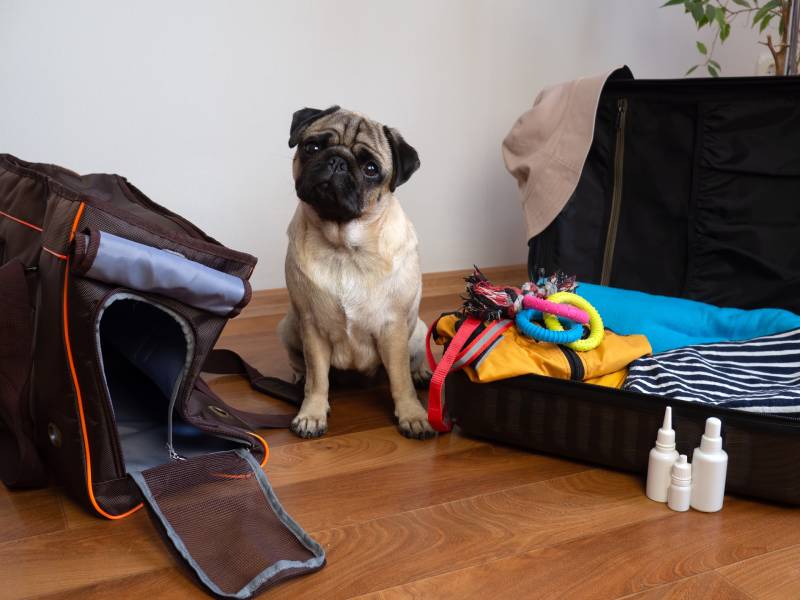
Vet approved
Reviewed & Fact-Checked By
Dr. Paola Cuevas
MVZ (Veterinarian)
The information is current and up-to-date in accordance with the latest veterinarian research.
Some dog owners take their beloved pooch with them everywhere, even if it means traveling with their dog to a different country. Traveling with your dog is easier than it used to be, with more pet-friendly accommodations readily available and fewer restrictions. However, when traveling to Mexico with your beloved pooch, you must be aware of the country’s laws, policies, and requirements to be fully prepared.
In this post, we’ll discuss eight tips to consider before heading out so that you have everything in place to avoid a headache once you arrive.
Before You Leave
There are two common ways to get to Mexico from the US: by air or by car. If you plan to fly, you’ll need to check all requirements for that particular airline, as they all have their own policies and regulations, which will be explained later. If you’re traveling by car, your dog must be in a carrier before entering. You cannot have your dog in your lap before crossing the border.
The 8 Tips to Consider Before Traveling to Mexico With Your Dog
1. obtain a rabies certificate.
Despite the ease of the country’s restrictions when it comes to dogs entering, you still need to carry the required rabies certificate. The certificate may be asked by border control before entering, and if you do not have the certificate, you and your dog will be denied entry into the country. The rabies certificate cannot be expired, and ensure all pertinent information is on the certificate, such as the date given, your veterinarian’s information, the expiration date of the vaccine, your name and address, as well as the breed, sex, age, and color of your dog.
When returning to the United States from Mexico, you will not need to present a rabies certificate because Mexico is not considered a high-risk country for the disease. However, you will still need to provide a written or verbal statement explaining that your dog has not been in a high-risk country over the past 6 months before being allowed entry back into the US. 1
2. A Health Certificate Is Not Required
Since 2019, a health certificate for your dog is no longer required for entry into Mexico if you’re coming from the US or Canada. However, your dog will still be physically inspected upon arrival by SENASICA. 2 The inspection involves checking for lesions, external parasites, and the overall healthy appearance of your dog.
3. Ensure You Know the Traveling Rules With Your Airline
Despite a health certificate being no longer required for entry into Mexico, the airline you use may still require one before being allowed to board. It’s imperative to check with your airline to ensure you have all documentation in place before arriving at the airport. Some airlines allow you to add your pet upon purchasing your ticket, but we recommend calling to verify your pet is added to your itinerary.
Most dogs are allowed to fly in the cabin with you (if it’s a small dog), but some require the dog to be placed in the cargo area. All airlines have their own policies, and some only allow service animals to ride in the cabin. There may also be fees associated with traveling with your dog.
4. Bring Up-to-Date Vaccination Records
Even though a health certificate is no longer required for entry into Mexico, it’s still wise to bring all current vaccination records to prove your dog’s clean bill of health. The records should be legible and include the dates the vaccines were given to show the status. Such vaccinations should include the following:
- Parainfluenza
- Leptospirosis
5. Bring Your Dog’s Medical Records
This may seem like overkill, but it’s best to be overly prepared should you run into any snags. The more proof of your dog’s health you can provide, the better. Border patrol may ask for these records even though a health certificate is not required. It’s also a good idea to provide a list of any medications your dog is currently taking.
It’s also advised to treat your dog for fleas, ticks, and heartworms before traveling to the country, and providing proof is also a good idea.
6. Take Your Dog to Mexico’s OISA
Upon arrival, you must take your dog to the Mexican Animal and Plant Health Inspection Office (OISA) for inspection. This is where SENASICA comes in for the physical inspection of your dog. They will check for external parasites (particularly ectoparasites), fresh wounds, or any signs of infectious or contagious diseases.
7. Have Your Dog in an Appropriate Carrier
Your dog’s carrier should be free from bedding, toys, or other accessories. If you leave these items inside, they could be destroyed, which can be heartbreaking if your dog’s favorite toy or blanket is confiscated. The carrier will also be sprayed for disinfecting purposes, so heads up.
8. Find Pet-Friendly Accommodations Before Arrival
Because of the high number of strays, there are claims that Mexico doesn’t hold dogs in high regard as we do in the US, but it’s getting better. That said, you will have a little harder time finding pet-friendly accommodations compared to the US, but it’s not impossible.
As for dining out, many restaurants do not allow dogs inside, but many cafes with outdoor seating are usually accommodating. It’s best to map out where you plan to go while you’re in the country and scope out any places you’d like to visit so you know where the dog-friendly places are. Remember that the better prepared you are, the better your experience will be.
It can be confusing figuring out what you need to travel to Mexico with your dog. If you’re driving , ensure you place your dog in a carrier before entering the border patrol, and leave out any bedding, blankets, or toys. When flying , ensure you know all requirements in order for your dog to travel with you.
- See also: Traveling With a Dog to Europe: 10 Vet-Approved Tips
- https://www.aphis.usda.gov/aphis/pet-travel/by-country/pettravel-mexico
- https://www.cdc.gov/importation/bringing-an-animal-into-the-united-states/dogs.html
- https://www.cdc.gov/importation/bringing-an-animal-into-the-united-states/dog-origin.html#:~:text= This%20dog%20may%20enter%20the , risk%20countries%20for%20dog%20rabies .
- https://apps.fas.usda.gov/newgainapi/api/report/downloadreportbyfilename?filename=Traveling%20With%20Pets%20to%20Mexico_Mexico_Mexico_3-11-2011.pdf
- https://www.cdc.gov/importation/bringing-an-animal-into-the-united-states/dog-origin.html#:~:text=This%20dog%20may%20enter%20the,risk%20countries%20for%20dog%20rabies
Featured Image Credit: Yekatseryna Netuk, Shutterstock
Related Articles
Further Reading
Black Miniature Schnauzer – Facts, Origin & History (With Pictures)
Feb 23, 2024 - 5 min read
Do Shih Tzus Sleep a Lot? Breed Resting Need & FAQ
Jan 16, 2024 - 4 min read
8 Best Christmas Pajamas for Dogs – 2024 Reviews and Top Picks
By Genevieve
Feb 9, 2024 - 8 min read
Vet Articles
Latest Vet Answers
The latest veterinarians' answers to questions from our database
How to Help an Abused Dog Recover: 8 Tips & Tricks
Answered by Dr. Sharon Butzke, DVM (Vet)
10 Wirehaired Pointing Griffon Facts (Explained By Our Vet)
Answered by Dr. Karyn Kanowski, BVSc MRCVS (Vet)
Betta Fish Popeye: Causes, Signs, & Treatment Explained By Our Vet!
Answered by Dr. Luqman Javed, DVM (Vet)
How to Aerate Water Without an Air Pump: Our Vet Explains
Dog Ear Hair Plucking: Our Vet Answers Concerns & Alternatives
How Should I Introduce My Puppy to a Dominant Dog?
Answered by Dr. Joanna Woodnutt, BVM BVS (Vet)
Cat food recalls
Have a cat? Stay on top of cat food recalls here >
Dog food recalls
Have a dog? Stay on top of dog food recalls here >
Have a question? talk to a vet online for advice >

Driving To Mexico With Dogs

September 2023
Jump Ahead To:
Bringing Pets to Mexico – US/Canadians only
Note: Only dogs and cats are considered pets by Mexico’s definition.
If you are driving to Mexico with your dog or cat, you do not need to spend the money to go to a veterinarian and get a health certificate.
You do not need to have a veterinarian provide proof that the pet has had parasite prevention.
You may need to show a rabies certificate for your dog or cat to enter Mexico. It varies from border crossing to border crossing. (TJ for example does ask for the rabies certificate)
BTW… when driving back into the U.S. the border agent will just do a visual inspection (from the car window rolled down).
If the dog is healthy looking, they will usher you through.
Here is a link from the USDA confirming the new requirements for bringing pets to Mexico.
Will my dog be inspected at the border?
Mexico border agents are not OISA officers. Therefore they are not part of the SAGARPA-SENASICA which oversees the importation of animals.
There is not an OISA office at the U.S. Mexico border. No one is there to inspect your pet.
Documents to have while traveling
Although Mexico does not require a health certificate to enter with your dog, it is always a good idea to have following documentation with you:
- An up-to-date rabies certificate. Some border crossing stations are asking for proof of a rabies vaccine.
- Vaccination record of vaccines and due dates (optional)
- Record of medications for flea/ticks/mites and lice. Plus, heart worm prevention. (optional)
Check List For Traveling with Dogs to Mexico
A Rabies booster is the only vaccine requirement Mexico has.
However, we dog-lovers want to keep our furry friends healthy.
This is especially true when traveling to another country.
Mexico has a lot of street dogs who are not vaccinated or treated for parasites.
Therefore, keep your dog current on vaccines such a Bordetella, Canine Influenza, DHPP Booster (K9 Distemper) and a parasite prevention medication.
Regarding the dog’s ID Tag worn on the collar – put your email address not a phone number.
If your dog gets lost and someone finds him/her… they probably cannot call a U.S. or Canadian phone number.
However, everyone can send an email at no cost to them. Just something to keep in mind. =8-)
Download the PDF version of this checklist!
Crossing the border back into the U.S.
Both Mexico and the U.S. requires proof of an up-to-date rabies vaccine for your dog or cat.
The U.S. border agent will do a visual inspection (windows rolled down) to make sure the dog/cat looks healthy.
More from the CDC on bringing your pet in to the U.S.
NEW Visitors Permits Requirements (for humans) To Enter Mexico
Getting a FMM is not the same as it used to be. The Mexico Immigration Office no longer allows tourists to visit Mexico for up to 180-days automatically.
A FMM is a visitors permit, known as Forma Migratoria Multiple or FMM. It is what you need to enter Mexico legally.
When driving across the border you will be required to complete the FMM card at the immigration office.
Often times the desk for the FMM is in the same building where the desk is for the TIP (temporary import permit, for cars) is located.
The immigration official will ask how long you intend to stay in Mexico.
Be sure to let them know your plans so that they provide you with sufficient days for your visit.
The immigration official may ask for proof of how long you are staying; such as hotel, Airbnb, and VRBO reservations. If you are flying out, show the airline ticket.
Be sure to surrender your FMM and TIP when leaving Mexico!
Their new systems will keep track of your entry and departure. The officials will look you up on their system before determining how many days they will allow you to stay in Mexico.
You can learn more about the FMM here.
Smart Safety Planning Tips
Never drive after dark. Get to your destination before the sun sets.
Stay on the Tolls roads (Cuotas) as much as possible.
If you see a gas station when your tank is half full, fill it up. Do not let your gas tank get below half full.
Make sure the gas pump is at $00.00 (zero) before they start pumping the gas.
Tell the gas station attendant exactly how much you want. For example, x amount in pesos, and try to pay with that exact amount. This will illuminate the chances of being short changed.
Keep two wallets. One with ~1,000 pesos. Use that to pay the tolls, gas, food. Replenish that wallet out of the sight of others.
Keep the 2nd wallet with the remainder of your cash hidden and out of sight.
Get a checking account at a bank that reimburses international fees at the ATM. Charles Schwab is good.
These are prudent safety tips for driving anywhere, not just in Mexico.
We have encountered many wonderful and kind people while driving throughout Mexico. It is unfortunate that a few like to prey on tourist. No different than in the U.S.
Travel Resources
The GrinGO App for traveling in Mexico.
WAZE is the best app for directions and up-to-date information on accidents and where the police are. All information is supplied by other drivers. It is also a great resource to contact other drivers around you to find out why you find yourself stuck in traffic.
On the Road In Mexico (with Bill Bell) Another great resource is the private Facebook group called On The Road In Mexico. Even if you are not a fan of FB, this private group is well worth joining.
There are 56K+ members who can help to answer your questions real-time with up-to-date travel information all throughout Mexico.
Make sure it is the one with Bill Bell as the Administrator.
Google Translate , as it allows you to use your phone’s camera to translate menus, signs, ads etc if you are not familiar with Spanish.
WhatsApp for free texting and internet phone calls all over the world.
Uber and DiDi for ride -share services. Very inexpensive in Mexico. Note: not all states in Mexico allow ride-share services.
As always… safe travels!
You may be interested in…
Flying to Mexico City with dogs – our step by step experience in 2023
Columbia Bridge Border Crossing – Details on crossing from Texas to Mex ico
Flying WITHIN Mexico with Dogs
Flying With an Emotional Support Dog or a Service Dog – What’s the Difference?
Pet Friendly Road Trip – from Texas to Central Mexico
Hello there quite a resourceful website, thank you for the information! Is there any specific policy on dog toys? My large shepherd has got quite a few and I intend to keep them in my car while driving into MX, would they be allowed or be required to be thrown at the border? I’d hate to spend hundreds buying them all again or might have to ship them to me after arrival into destination city.
Hola Patrick! I must say, this is the first time someone has asked this question. Thanks for asking!
The is not a specific policy regarding pet toys. The border agents will not bother with your dog’s toys, unless the toys still have the sales tags on them. They may think you are going to resell them. Which is frowned upon.
The pet toys will be fine to bring with you on your drive to Mexico. Safe travels! =8-)
Hi, I’ll be driving to Mexico City from Dallas in January with two large dogs (labrador retrievers). I’ve heard mixed messages on the required use of crates while crossing the boarder. I know that when flying, obviously crates are required, but in your experience, did the border crossing agents require your dog to be contained in a crate?
Hola Allan! You do not need to put your dogs in a crate when driving across the border. When you go through the inspection station for your car, be sure to take the dogs out and away from the car. They don’t care about the dogs. They are more interested in items you could bring over the border to sell. Such as liquor and computers. Enjoy your trip to Mexico City – my favorite city! =8-)
Hi I’m driving up to the Mexico border with my cat and family she is up to date with her rabies vaccine. She also has a rabies certificate so my question is do I need anything else? Or is that it and do I needs health certificate as well? Also when I go to to the cross Mexico border from the U.S. is there anything I can expect from them? What does this mean? “they will be inspected by SENASICA upon arrival” is it an office that I have to stop by after crossing? The whole website is confusing me … Read more »
Hola Cristina, There is no OISA/SENASICA office at the border. No one will ask to inspect your cat.
No health certificate required.
The only requirement Mexico has for pets coming from the U.S. and Canada is an up-to-date rabies vaccine certificate. Nothing else.
The border agent in Mexico may not even ask to see the rabies certificate. It depends from border crossing to border crossing.
I hope this clears up any confusion you had. =8-)
Do you know if I will I need anything when turning to the U.S border?
Hola Cristina! Bring an up-to-date Rabies Certificate. Just in case they ask. They may ask you to roll down the window in order to see the dog and make sure he/she looks healthy. =8-)
Hi, I’m going to Ensenada in a few weeks (crossing in Tijuana), driving down from Canada with my dog. I have a question regarding the rabies “certificate”. My dog has an international health “passport” showing all vaccinations and due dates. Will that be sufficient or do I need an actual letter from our vet? Also, how do they check if I did the tick/flea prevention? Is a recent receipt from the vet sufficient? Thank you for helping me out!!!
Hola Erika, Thanks for the question. =8-) The border agents in Mexico want to see a specific letter stating that your dog has been vaccinated against rabies. They really don’t care about the flea/tick prevention. I am sure your vet will know what the rabies certificate/letter should include, however just in case, here is what to include: Date of last booster. Duration of the booster. Date when the next booster is due. Manufacturer. Serial number. Lot expiration. Microchip number for your dog, if you have one. Signature and license number for the veterinarian. Have a great time in Ensenada! Safe … Read more »
thank you for your quick and comprehensive reply! Just to make sure – I do NOT need a health certificate like apparently was needed in the past, just the rabies letter?
Correct, no health certificate required to enter Mexico if you are from the U.S. or Canada.
thank you so much! That’s very helpful!
Hi! I am going to Ensenada from Los Angeles on a road trip with my family and I will be bringing my dog. What paperwork do I need for my dog so I won’t have any issues at the border coming back home?
Hola Jackie! Believe it or not, the border crossing from California IN to Mexico with a dog (especially at San Ysidro to Tijuana) will be more of a hassle. The border agents in Mexico will want to see the up-to-date rabies vaccine certificate. Bring that and a list of recent vaccines your dog has had. Crossing back into the U.S. will seem much easier. The U.S. border agents are making sure no sick dogs come into the U.S. They will just do a quick visual inspection from the car and then wave you through. They don’t ask for a rabies … Read more »
Ok so do u have to have them registered and vaccinated to bring them in to Mexico or not
Hola Carmen, Dogs/cats need to have up-to-date rabies vaccinations. Bring the certificate with you. I don’t know what you are referring to when you say “registered”. You do not need to registered your pet with an agency. Hope this answers your question. =8-)
So I decided to take my pups last minute with me to Cancun, Veracruz, & Xalapa. I have a Mexican passport. I’m traveling via airlines. It’s all good with my airline, BUT I’m worried about getting them in Mexico. I have dogs & they have been in the US since birth for 6 years. They are all up to date on their shots and just got their regular check up on Jan 13, 2023. I’m set to leave March 17, 2023 & not sure what I need. The websites are a bit confusing. I would appreciate your help. Thank you!
Does they airline you are flying with require health certificates?
They don’t. But I’m not sure about Mexico’s policies to enter Mexico.
Hi Ailed…I provide all the information on what is needed in my blog post here: https://www.travelingwith2dogs.com/traveling-with-dogs-to-mexico-the-facts/
If you have further questions, please let me know. =8-)
Dos anyone knows people who can transport dogs from Sacramento, California area into Guadalajara, Mexico?
Hola Manuel, I don’t know of a pet transportation company. I think you might have better luck posting this question in the private Facebook group called ON THE ROAD IN MEXICO hosted by Bill Bell. Give them a try. =8-)
I am hoping you could help advise about dog food. I have seen on several websites where you can only bring one day’s worth of food for your dog. We are driving into Baja, it will take 3-4 days to get to our destination, and will be there with two dogs for 3 months. They are both on prescription diets, and one is a diabetic so the right food is critical. Can you present a prescription for food at the border, and thereby be allowed to bring in a large supply? The diabetic dog is a big Labrador retriever so … Read more »
Hola Chase! I can appreciate the concern for bringing a large amount of food into Mexico for your diabetic dog. Here are my suggestions. When packing up the car, don’t make it obvious you are bringing a large amount of dog food. Separate the food into different suitcases. Take them out of any retail packaging (i.e., case of canned food wrapped in plastic). Bring the receipts showing you purchased the food for your dogs. The border agents want to make sure you are not bringing in food to sell in Mexico. If you are even asked, you can legitimately show … Read more »
This is so very helpful. Thank you! We did get an alternative recommendation from our vet we should be able to get at Costco after arrival but this should help us get at least enough food to get down to Los Barriles, and a few days before we make the trek to Cabo for supplies. We will carry the invoice and script from the vet as well just in case they ask. Again thank you for the help!
Hello! We are going to Puerto Vallarta Mexico in a few months and we cross the tj border by car but then we will take the bus from tj to Puerto Vallarta and we are taking my chihuahua terrier mix with us. Do you know what we might need for her to go on the bus ?
Hola Ally! So you want to take your furry friend with you on the bus. You don’t need any special paperwork. However, keep in mind that they will not allow you to take the dog inside the bus with you. The dog has to go under the bus where the luggage is stored. Years ago, we tried taking our small dogs on the bus in Guadalajara. They would not allow them inside the bus with us even though they were in their carriers. We tried talking to the manager of the bus line and she refused. There was no absolutely … Read more »
By continuing to use this website, you consent to the use of cookies in accordance with our Cookie Policy.
U.S. tourist faces 12 years in prison after taking ammunition to Turks and Caicos
An Oklahoma man faces up to 12 years in prison on a Caribbean island after customs officials found ammunition in his luggage.
Ryan Watson traveled to Turks and Caicos with his wife, Valerie, to celebrate his 40th birthday on April 7. They went with two friends who had also turned 40.
The vacation came to an abrupt end when airport staff members found a zip-close bag containing bullets in the couple's carry-on luggage. Watson said it was hunting ammunition he had accidentally brought with him — but under a strict law in Turks and Caicos, a court may still impose a mandatory 12-year sentence.
"They were hunting ammunition rounds that I use for whitetail deer," Watson told NBC Boston in an interview conducted last week that aired after their first court appearance Tuesday.
"I recognized them, and I thought, 'Oh, man, what a bonehead mistake that I had no idea that those were in there,'" he said.
The couple were arrested and charged with possession of ammunition. Authorities seized their passports and explained the penalties they faced.
Valerie Watson said in the interview: "When I heard that, I immediately was terrified, because I was like we can't both be in prison for 12 years. We have kids at home, and this is such an innocent mistake."
The charges against her were dropped, and she returned home to Oklahoma City on Tuesday after the court hearing to be reunited with her two young children.
"Our goal is to get Ryan home, because we can’t be a family without Dad," she said.
The couple also spoke about the financial burden of a much longer-than-planned trip. "This is something that we may never recover from," Ryan Watson said.
The U.S. Embassy in the Bahamas issued a warning to travelers in September about a law that strongly prohibits possession of firearms or ammunition in Turks and Caicos, an overseas British territory southeast of the Bahamas that is a popular vacation spot.
It said: "We wish to remind all travelers that declaring a weapon in your luggage with an airline carrier does not grant permission to bring the weapon into TCI [Turks and Caicos Islands] and will result in your arrest."
The embassy added: "If you bring a firearm or ammunition into TCI, we will not be able to secure your release from custody."
The embassy and the government in Turks and Caicos did not immediately respond to requests for comment.
The same thing happened to another American, Bryan Hagerich, of Pennsylvania, who was arrested after ammunition was found in his luggage before he tried to board a flight out of Turks and Caicos in February. He said he accidentally left it in his bag.
Hagerich was on a family vacation with his wife and two young children but has now been in the country for 70 days. He spent eight days in prison before he posted bail.
"It’s incredibly scary. You know, you just don’t know what the next day may bring — you know, what path this may take," Hagerich told NBC Boston.
"You know, it’s certainly a lot different than packing your bags and going away with your family for a few days. It’s been the worst 70 days of my life," he said.
Hagerich, once a professional baseball player, was drafted by the Florida Marlins in the MLB 2007 June amateur draft from the University of Delaware.
His case goes to trial May 3.
Patrick Smith is a London-based editor and reporter for NBC News Digital.

A freeze warning is in effect for early Friday morning. Protect sensitive plants or bring them in overnight.
- Storm Team 10 Forecast
- Severe Weather Alerts
Rhode Island children stranded in Mexico after medical emergency
by LEANNA FAULK, NBC 10 NEWS
(WJAR) — Two Rhode Island children are stranded in Mexico after a medical emergency abroad a cruise ship.
Sarah Martin sent her kids on a spring break cruise vacation with their grandparents, which was smooth sailing until their grandmother had a heart attack.
Now, her kids are stuck in Mexico with no passport, and no way to get to home.
"They were having the time of their lives just having so much fun," said Martin.
The fun stopped when she said their grandmother suffered a heart attack.
According to Martin, she was too critical to return to their original port of Miami.
The family was rushed to a local hospital in Cozumel where their grandmother remains in a medically-induced coma.
"They keep on asking me the same thing, mommy, how am I gonna get back to you? And it's just really sad because I don't have an answer," said Martin.
- MORE NEWS: Riverside business seeks local support amid Washington Bridge traffic
Some cruises that begin and end in the United States do not require guests to have a passport, however they are encouraged.
Now, Martin is begging the US Embassy for a lifeline to allow them to fly home.
"The US Embassy was misinformed on all of the options that we had. Nobody would help me," she said.
Martin said her 8-year-old son is days away from finishing his epilepsy medication.
"I don't want him to you know, join as his grandmother at the hospital," she said.
"I can fall down and crumble when they're not on camera. But when I'm on camera with them. I have a brave face, and I think it's helping them be brave."
An hour after NBC 10 reached out to Carnival Cruise, Martin said the company called her and confirmed they were in contact with the Embassy.
She said they are working to get her kids on a flight home as soon as Tuesday.

IMAGES
VIDEO
COMMENTS
YES: See Step 4. NO: Dog is not allowed to enter the United States. The microchip number must be listed on the dog's rabies vaccination certificate. If you are unsure whether your dog has an ISO-compatible microchip, please contact your veterinarian for assistance.See What Your Dog Needs to Enter the United States. *The applicant is responsible for making sure the dog has an ISO-compatible ...
Travel Requirements Based on Pet Type. Effective 12/16/2019: A health certificate for dogs and cats is no longer needed to enter Mexico. Dogs and cats may be taken to the border without health certificate documentation, they will be inspected by SENASICA upon arrival. Please follow the guidance on this page.
The Centers for Disease Control and Prevention (CDC) has implemented a temporary suspension for dogs entering the United States, specifically those that do not have a current U.S. rabies vaccine and are returning from 113 high-risk rabies countries, as designated by the CDC. Check the summary of most recent changes.
If you have questions about CDC requirements, contact CDC-INFO or call them at 404-718-3660. This page will guide you through the requirements for bringing privately owned, pet dogs into the United States from another country, including U.S. returning dogs. If you're bringing dogs into the United States for commercial sale or adoption ...
April 29, 2023. Bringing dogs from Mexico to the US is a very straight forward process, as long as you are aware of the requirements, and plan ahead. As long as your dog has remained in Mexico for the past 6 months, bringing dogs from Mexico to the US is easy. You will simply need to visit the vet and organise your means of travel.
You must apply online for a CDC Dog Import Permit. It is recommended to apply at least 8 weeks before intended travel. Before beginning the process, your dog must: Have a valid CDC Rabies Vaccination and Microchip Record [PDF - 1 page] Have a valid rabies serologic titer from an approved laboratory.
Pet Travel. Take a Pet From the United States to Another Country (Export) Bring a Pet From Another Country into the United States (Import) Take a Pet From One U.S. State or Territory to Another (Interstate) USDA-Accredited Veterinarians: Certifying Pets for International Travel; Traveling With Food or Agricultural Products
To enter the US from Mexico with a dog, one must ensure that their furry friend has stayed in Mexico for at least 6 months and possesses a health certificate. If they have traveled to a high-risk country, they may also need a microchip and rabies vaccination. It's important to note that the health certificate validity must be within 10 days ...
Tel: 202-485-8000 or 1-800-333-4636 and then press 5. Fax: (202) 663-3636. Note: The office suspended in-person counter service during the COVID-19 pandemic and is only offering mail-in service at this time. You should expect delays processing your request for authentication services.
Yes, on most flights up to 11 hours and 30 minutes traveling within the US (excluding Hawaii) or to Canada, Mexico, Central America, and some other destinations. Dogs must be at least eight weeks old.
Importations of pets and/or wildlife may be subject to state/municipality veterinary health regulations, federal quarantine, agriculture, wildlife, and customs requirements and/or prohibitions. Pets taken out of the U.S. and returned, may be subject to similar requirements as those entering for the first time. For some species occasionally considered as "pets," reentry may be prohibited.
Bringing a Cat Into the US. A veterinarian issued a health certificate to state your pet is healthy and fit to fly. This certificate must be completed within 10 days of travel. (not required by t he CDC or the USDA, but may be required by the airline) Cats are not required to have proof of rabies vaccination for importation into the United States.
What Dogs Need. On December 16, 2019, the United States Department of Agriculture announced that cats and dogs traveling to Mexico from the U.S. no longer need a health certificate. The rules now state that travelers with the pet dogs and/or cats must visit the Mexican Animal and Plant Health Inspection Office (OISA), and see the person working ...
Rescuing a dog from Mexico comes with an adoption fee, and costs can vary depending on the sanctuary. The average cost to adopt is between $300 - $500 USD for most breeds. Depending on where you are adopting from, additional fees may include vaccinations, spaying or neutering services, transport of the animal, and more.
Southwest Airlines. On Southwest, a Dallas-based carrier, two checked bags can fly at no cost, but not pets. Southwest charges $125 per pet carrier on its flights.. Dogs or cats are allowed to ...
The average fee for a one-way flight to Mexico for your dog, ranges from $99 to $125. That does not include potential additional fees such as veterinarian costs; dog food, and an airline accepted pet crate, for a total ranging anywhere from $350 to $650 for a round-trip flight for your dog from the U.S. to Mexico.
Last Modified: March 30, 2024. Print. Animals entering the United States may be subject to regulation by APHIS and other Federal agencies. Depending on your destination State, your pet may need to meet State entry requirements in addition to Federal entry requirements. Pet owners are responsible for meeting all Federal and State requirements.
After your trip, re-entering the United States with your dog should be fairly simple if you remember to do one very important thing. You need to provide a certificate of rabies vaccination obtained within 12 months of your trip, but no less than 30 days prior to re-entry into the U.S. After presenting the document, your dog will have to pass a ...
Arriving with your pet in Mexico. You are permitted to import two pets (cats, dogs, or a cat and dog) into Mexico. This limit is per person, so if you are a couple, you can import up to 4 pets. Note that if you import more than 3 pets, you will need to pay additional fees. See the website links below for details and procedures.
The 8 Tips to Consider Before Traveling to Mexico With Your Dog. 1. Obtain a Rabies Certificate. Despite the ease of the country's restrictions when it comes to dogs entering, you still need to carry the required rabies certificate. The certificate may be asked by border control before entering, and if you do not have the certificate, you and ...
Crossing the border back into the U.S. Both Mexico and the U.S. requires proof of an up-to-date rabies. vaccine for your dog or cat. The U.S. border agent will do a visual inspection (windows rolled down) to make sure the dog/cat looks healthy. More from the CDC on bringing your pet in to the U.S.
Regardless of where in Mexico you decide to fly your dog to, it is a simple process - if you're coming from the U.S. or Canada. If you are NOT flying from the U.S. or Canada with your dog, you must present an original "Good Health Certificate" (along with a non-certified copy) valid for at least 15 days after issuance.
Pet Travel to a foreign country can be complex and time-consuming. Before you start the process, you will need to know the following: the type of animal traveling, the destination country, the date of departure from the United States, and whether or not the pet will be traveling alone, as cargo, or with a person in the cabin of the plane.
Government officials from the United States and Mexico met virtually today, April 19, 2024, for the U.S.-Mexico High-Level Economic Dialogue (HLED) Mid-Year Review. HLED principals discussed joint accomplishments and progress on the dialogue's ongoing workstreams since the third HLED Ministerial in Washington, D.C. on September 29, 2023. The U.S. delegation was led by Under Secretary […]
Thomas Lee Robison, 58, of Santa Fe, New Mexico, "may have attempted to go down the Colorado River with his dog, who is a Welsh corgi, on a self made raft," the National Park Service said in a ...
Ryan Watson traveled to the popular vacation spot with his wife to celebrate his 40th birthday. The vacation came to an abrupt end when airport staffers found bullets in the couple's carry-on ...
When you travel with a pet, your destination State or Territory may have animal health requirements, such as obtaining a health certificate, updating vaccinations, diagnostic testing, or administering treatments. As soon as you know your travel details, contact your local veterinarian to help with the pet travel process.
"The US Embassy was misinformed on all of the options that we had. Nobody would help me," she said. Martin said her 8-year-old son is days away from finishing his epilepsy medication.